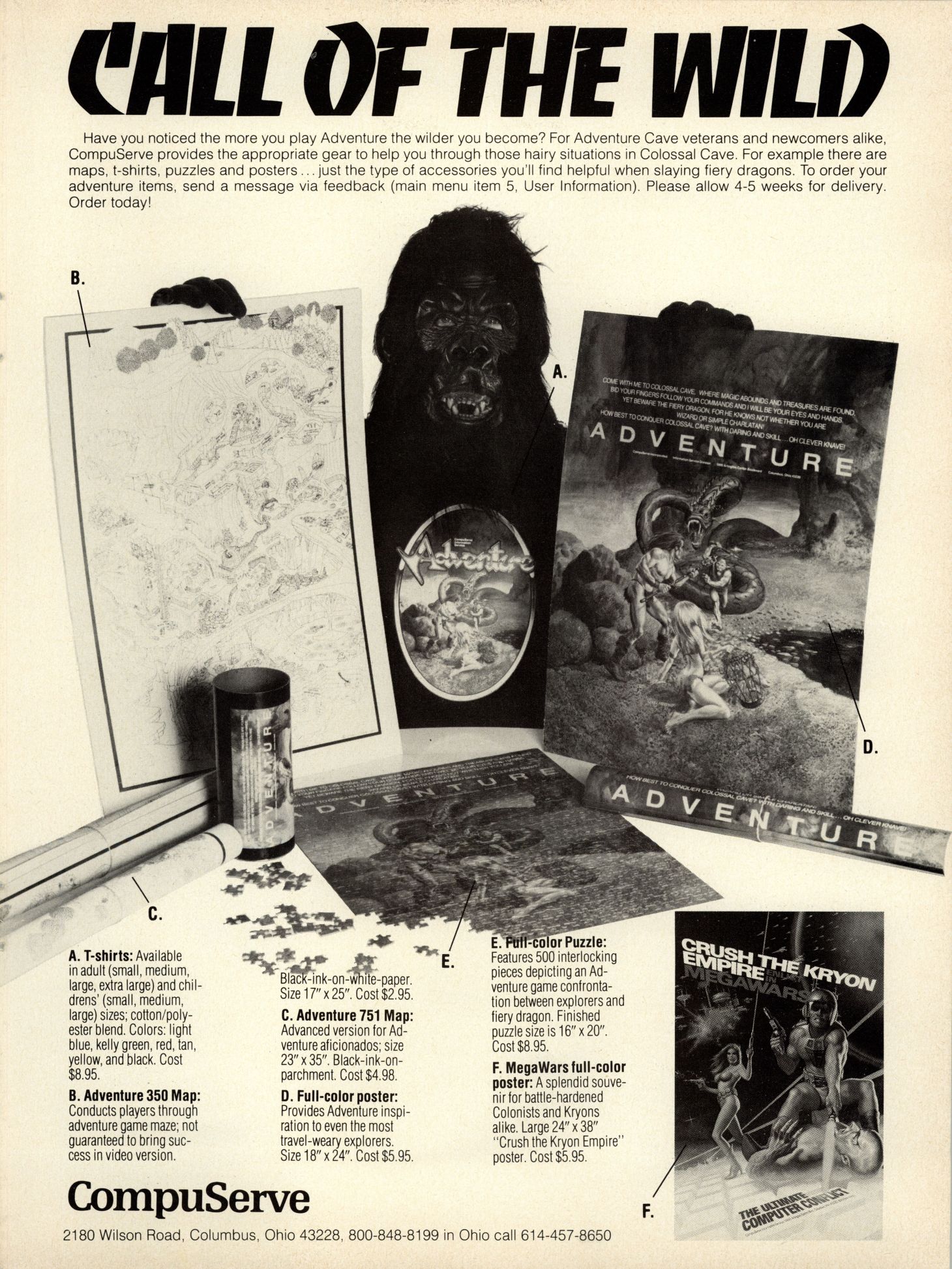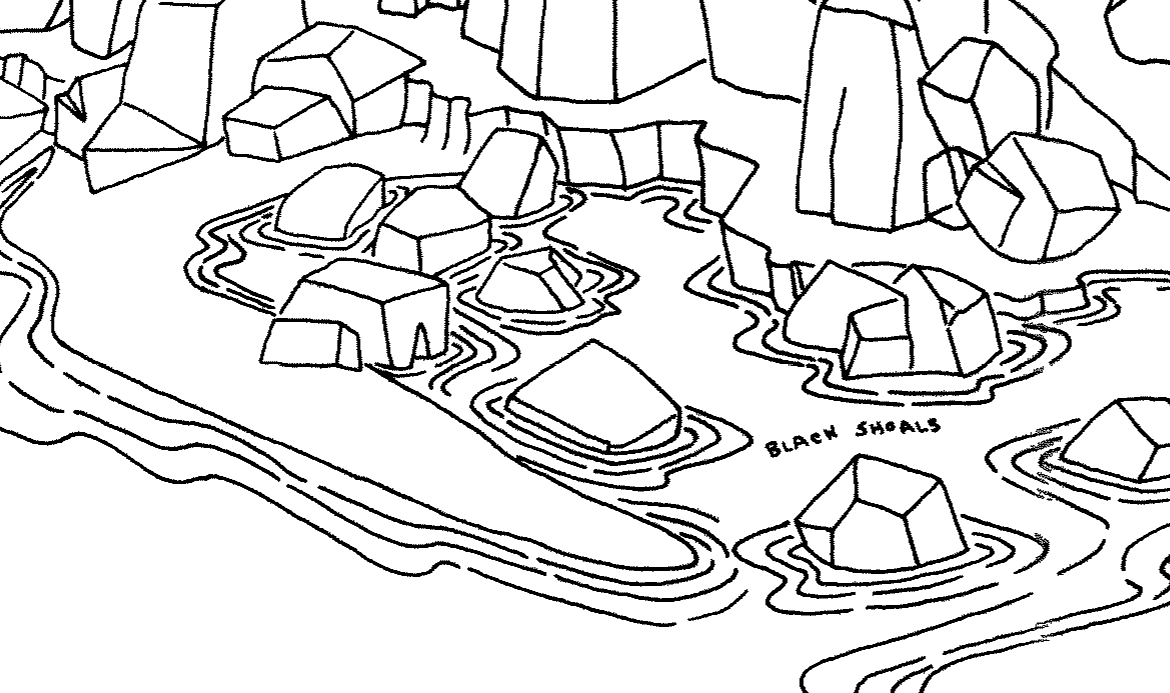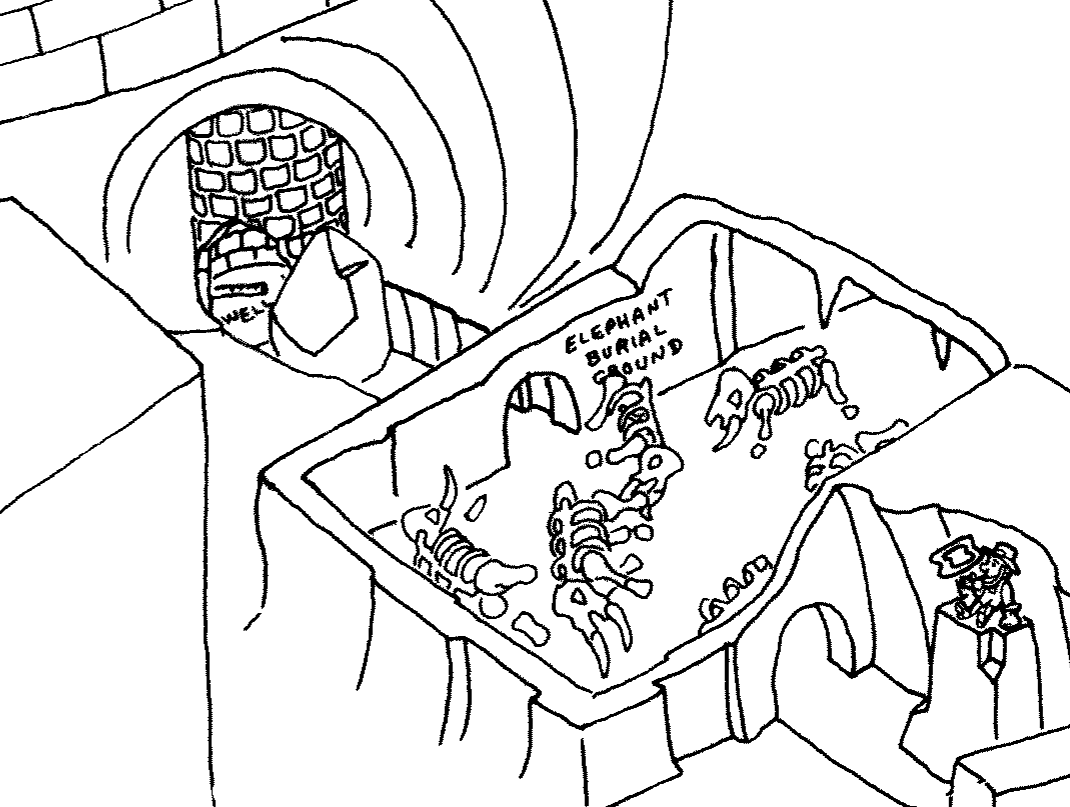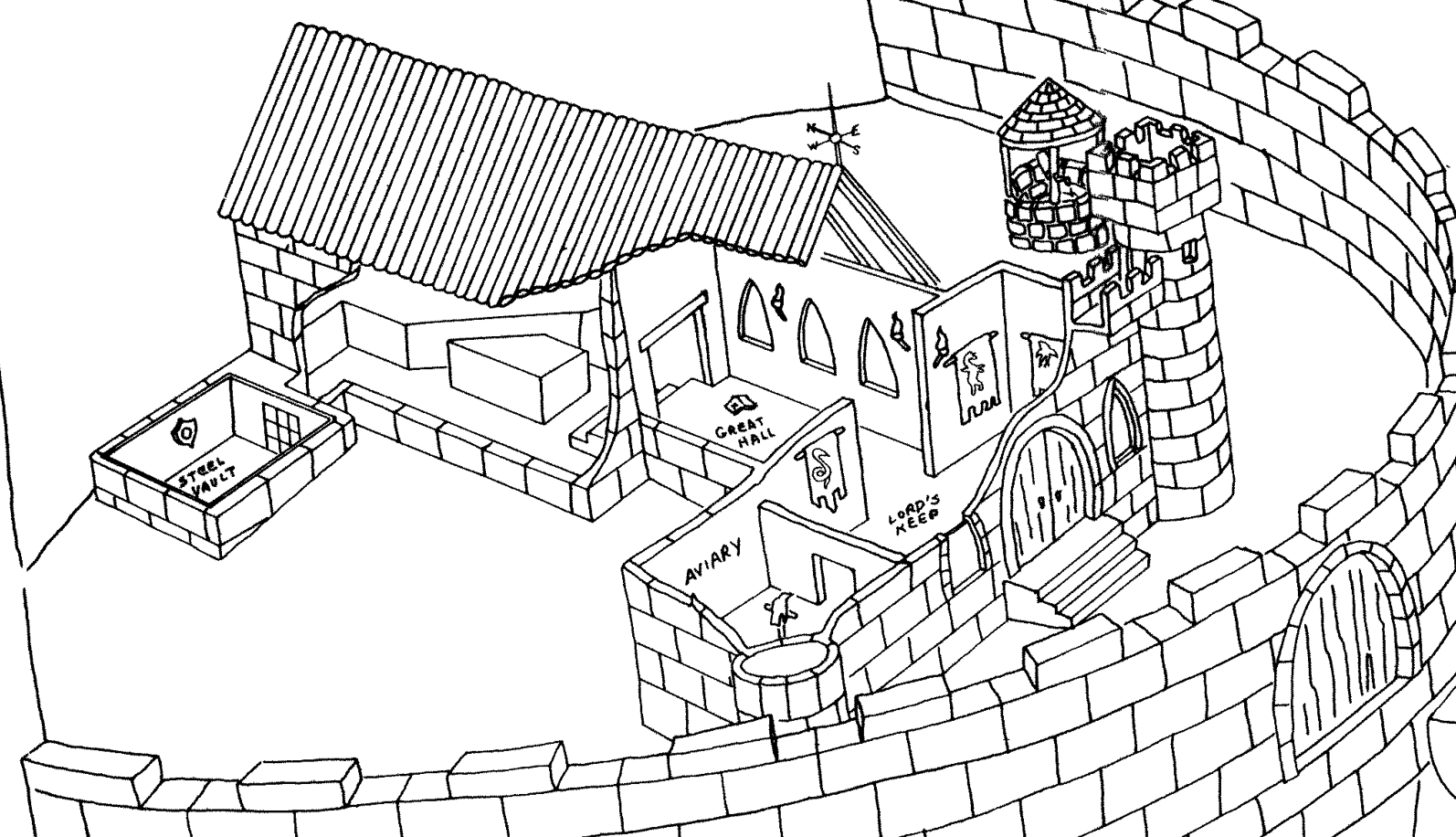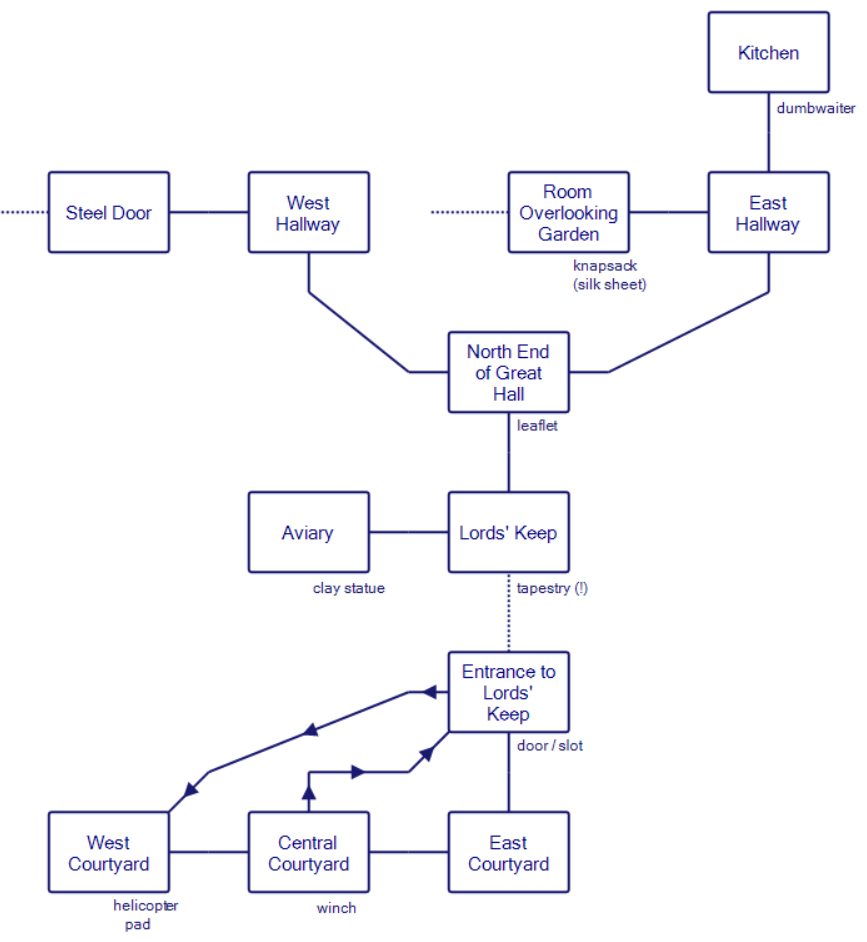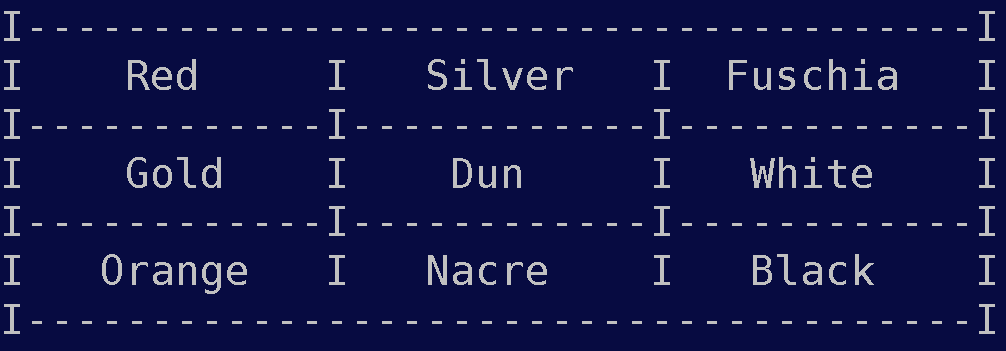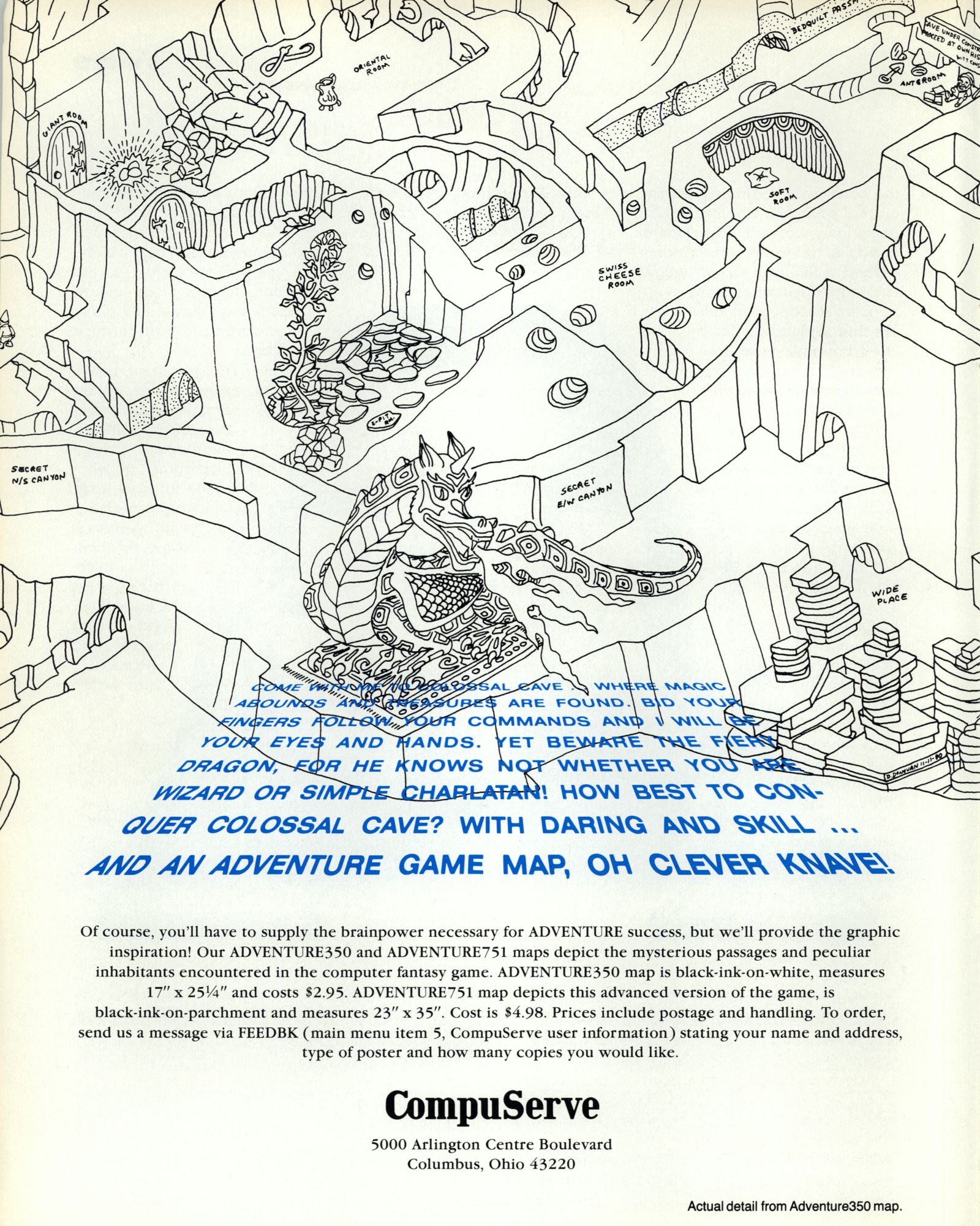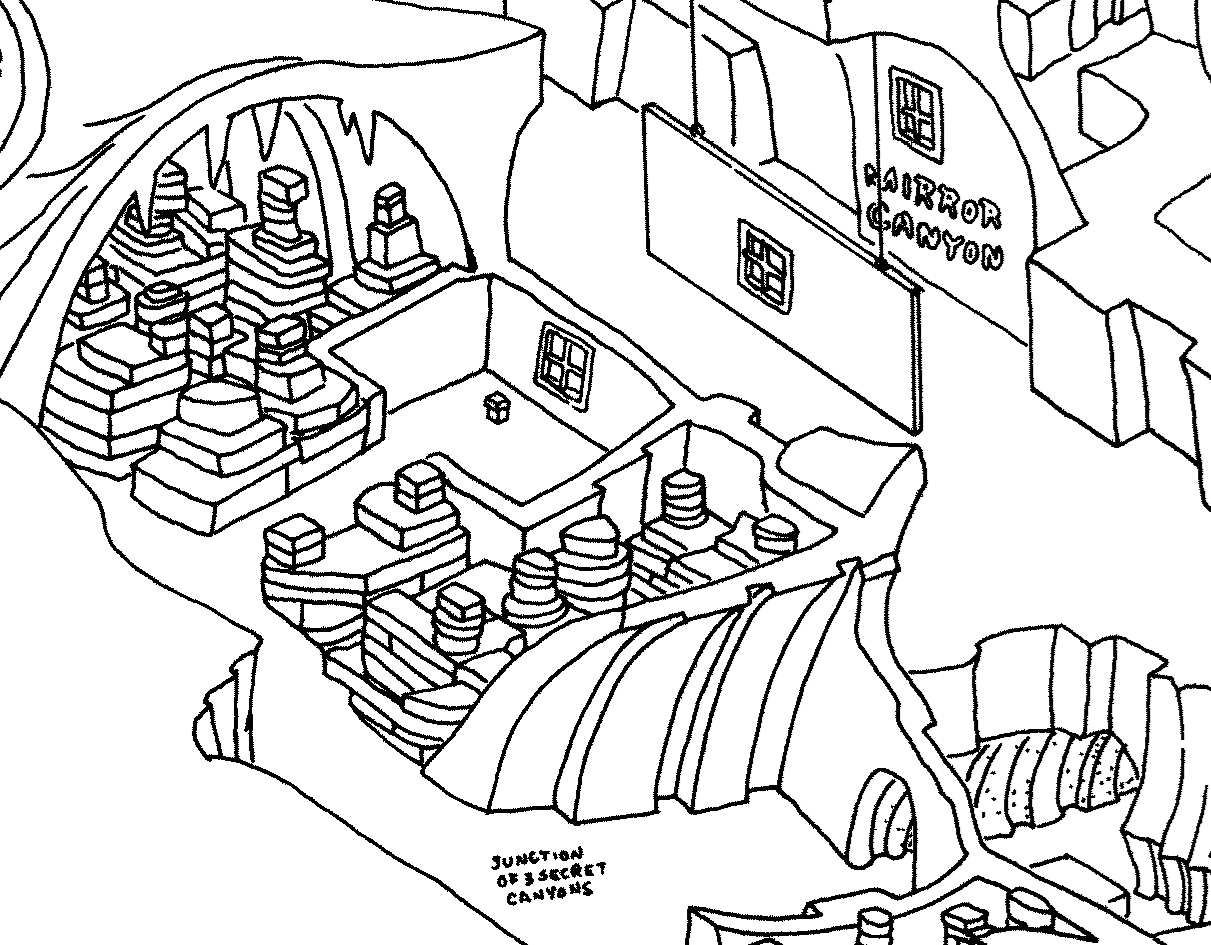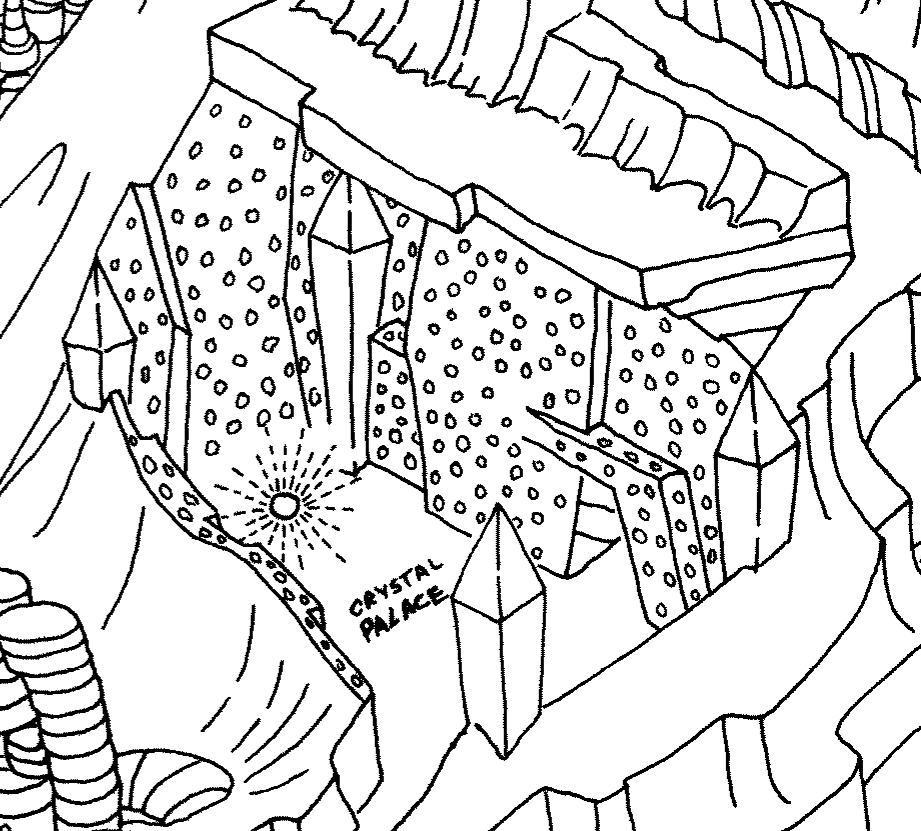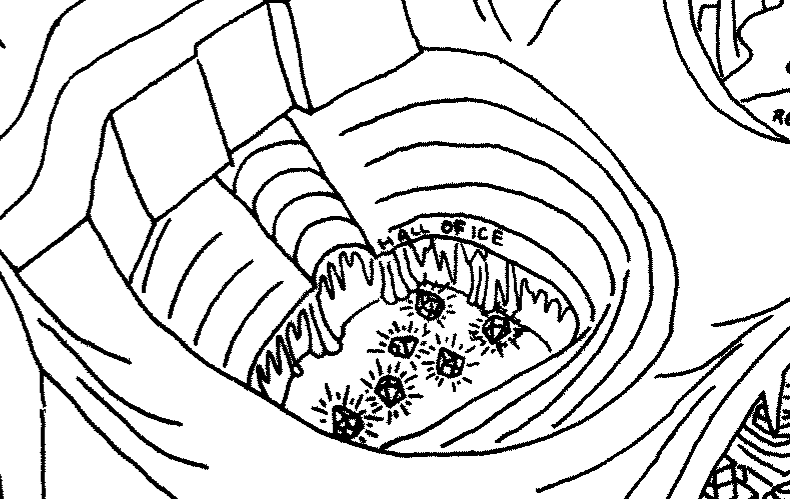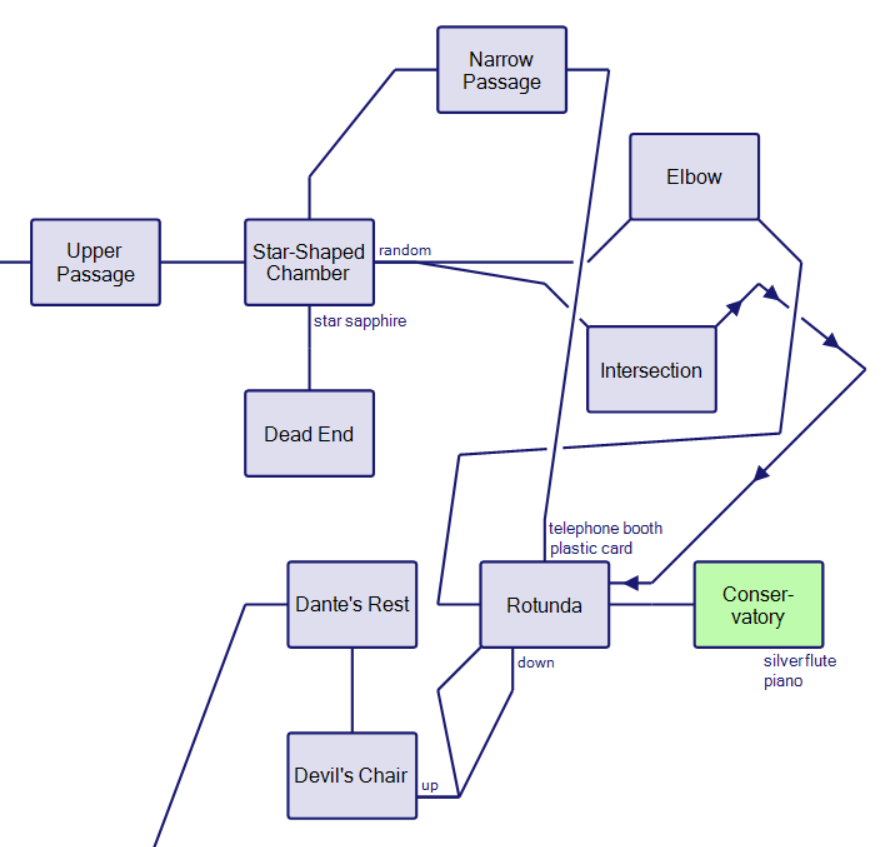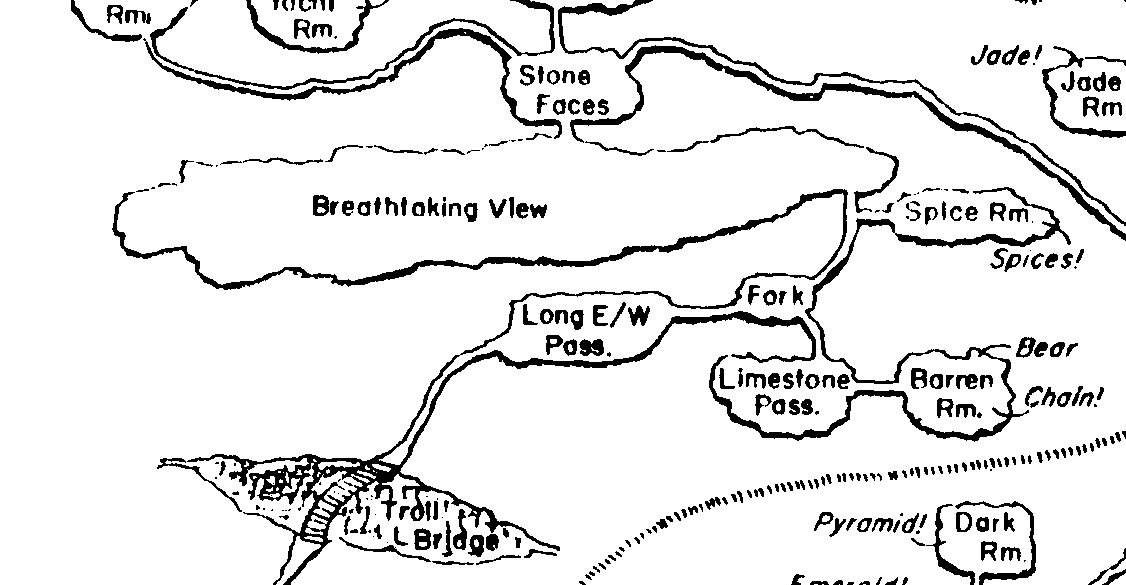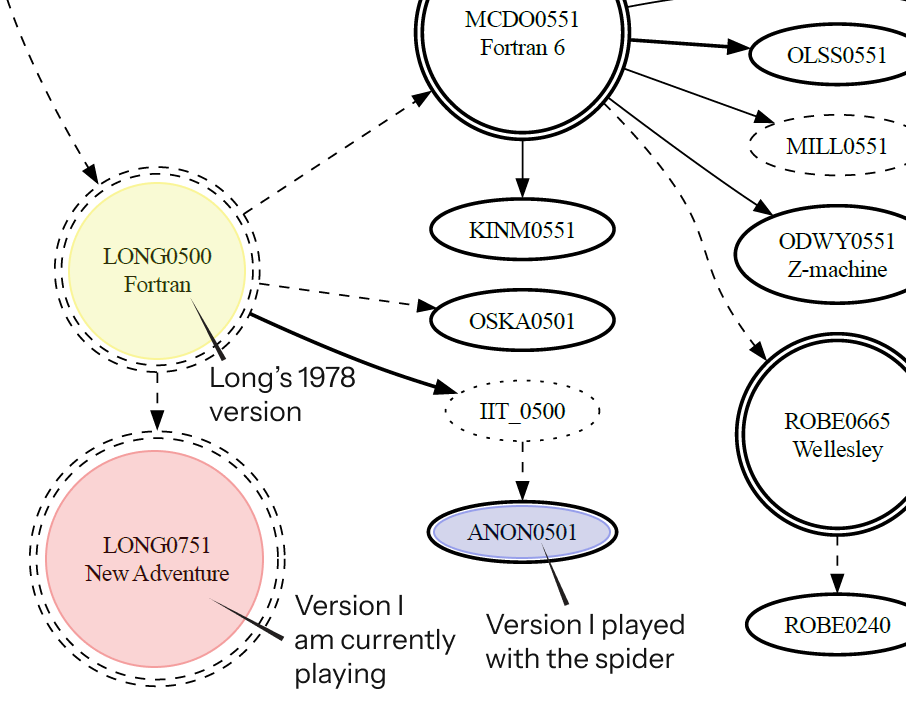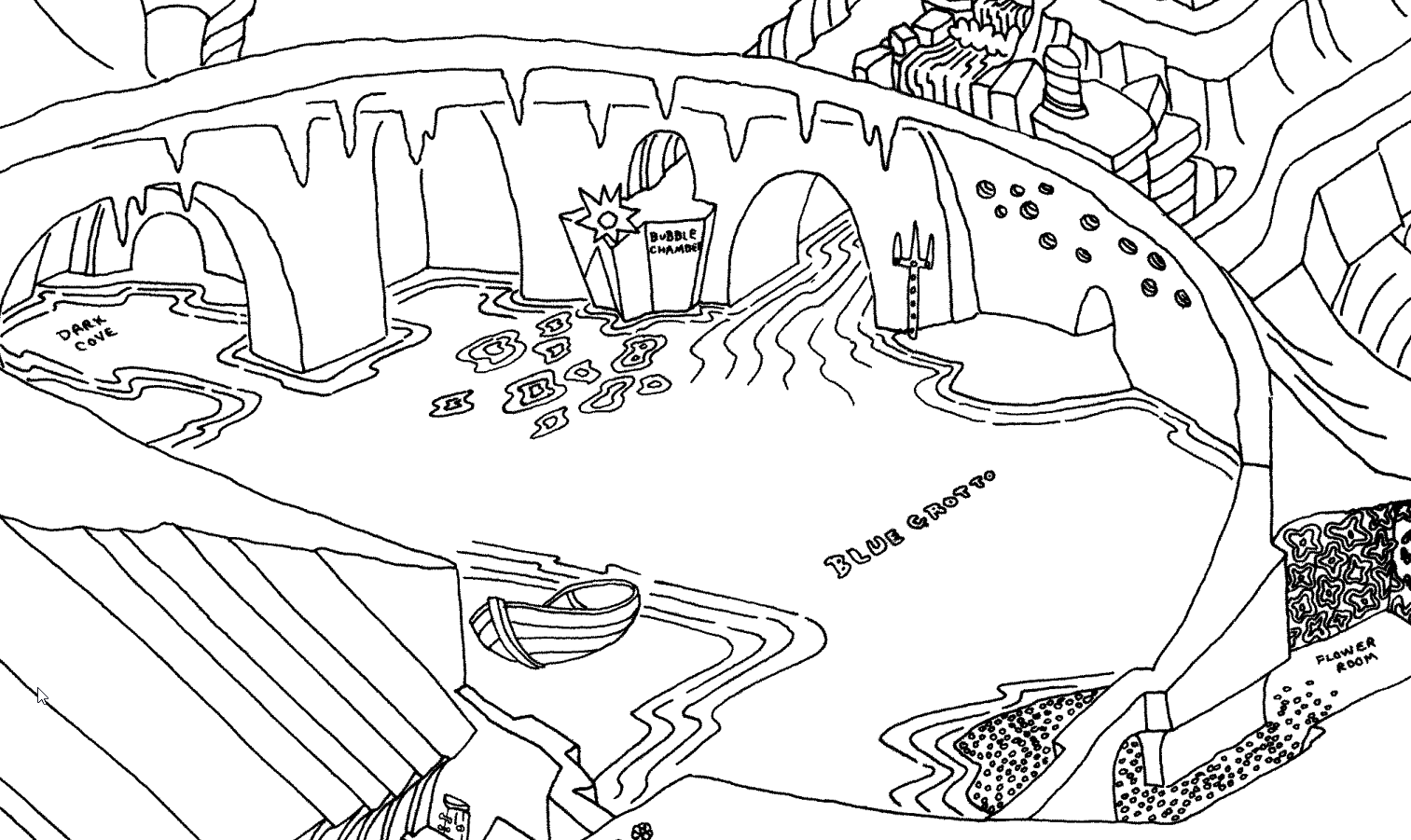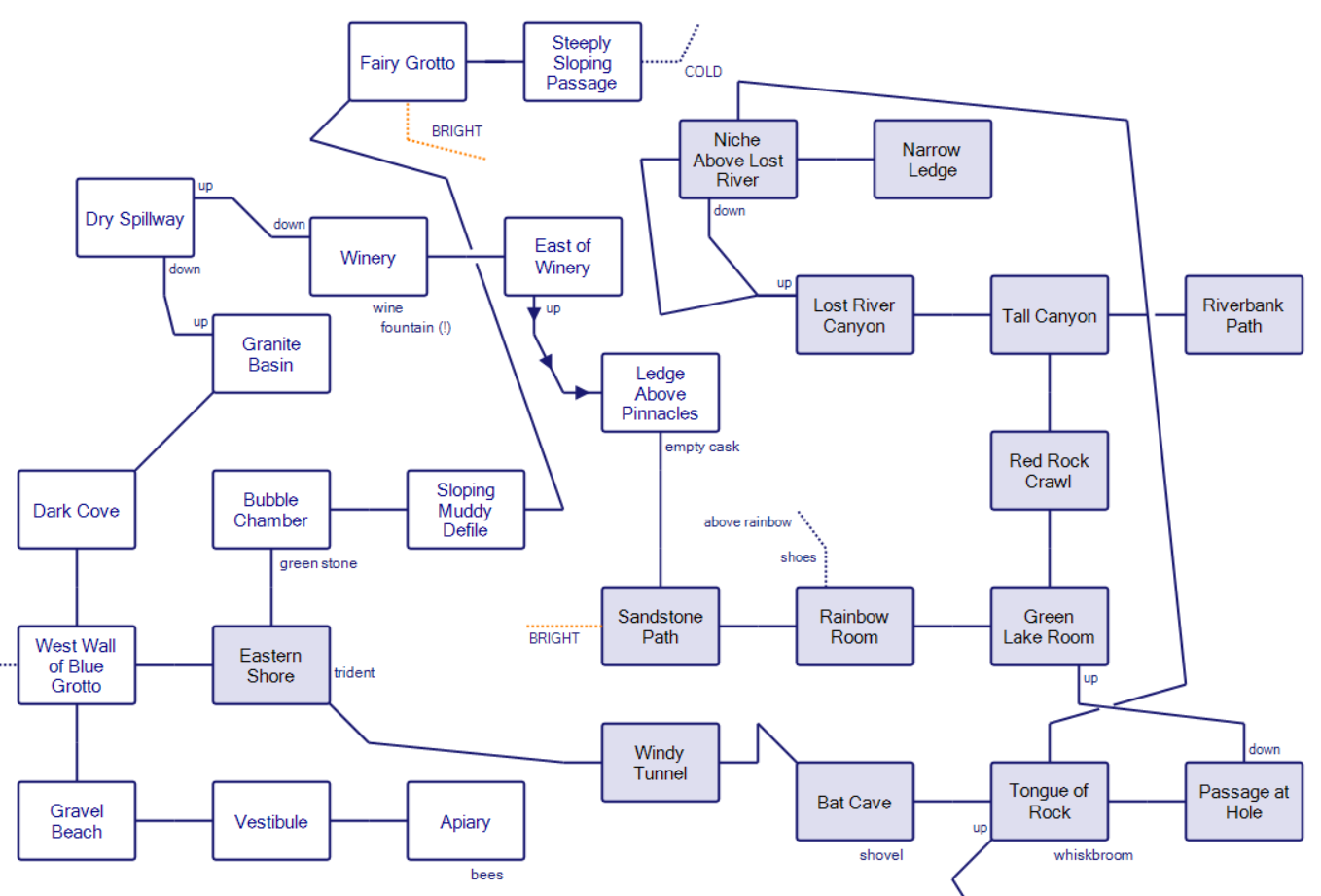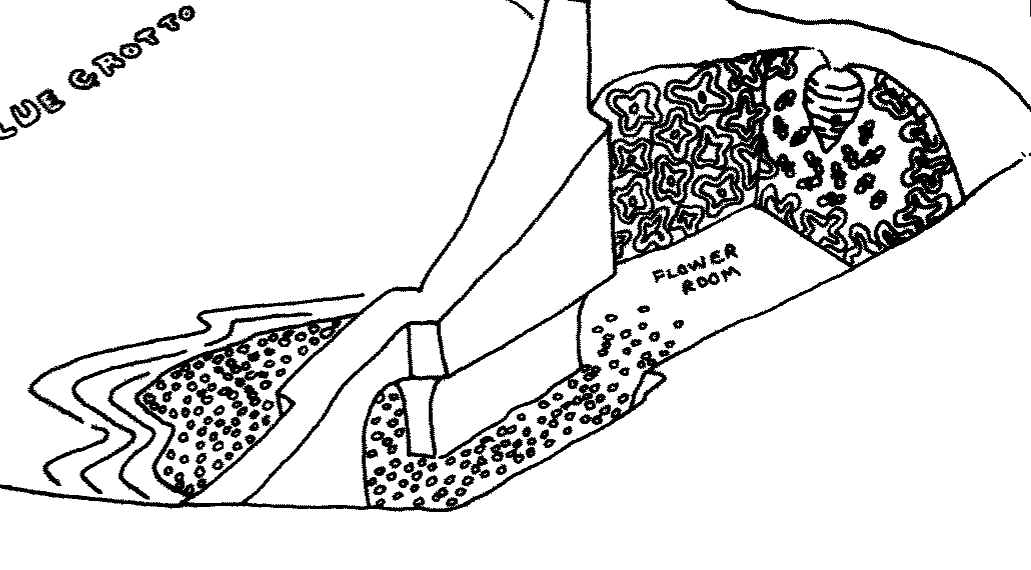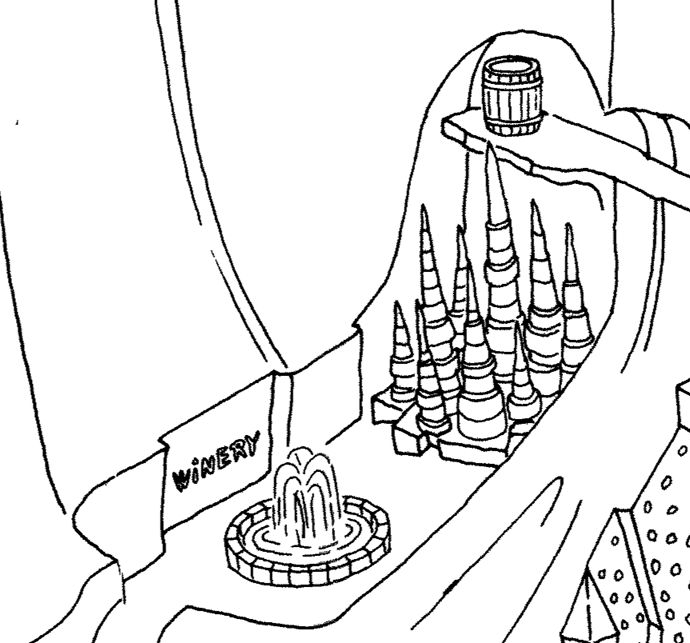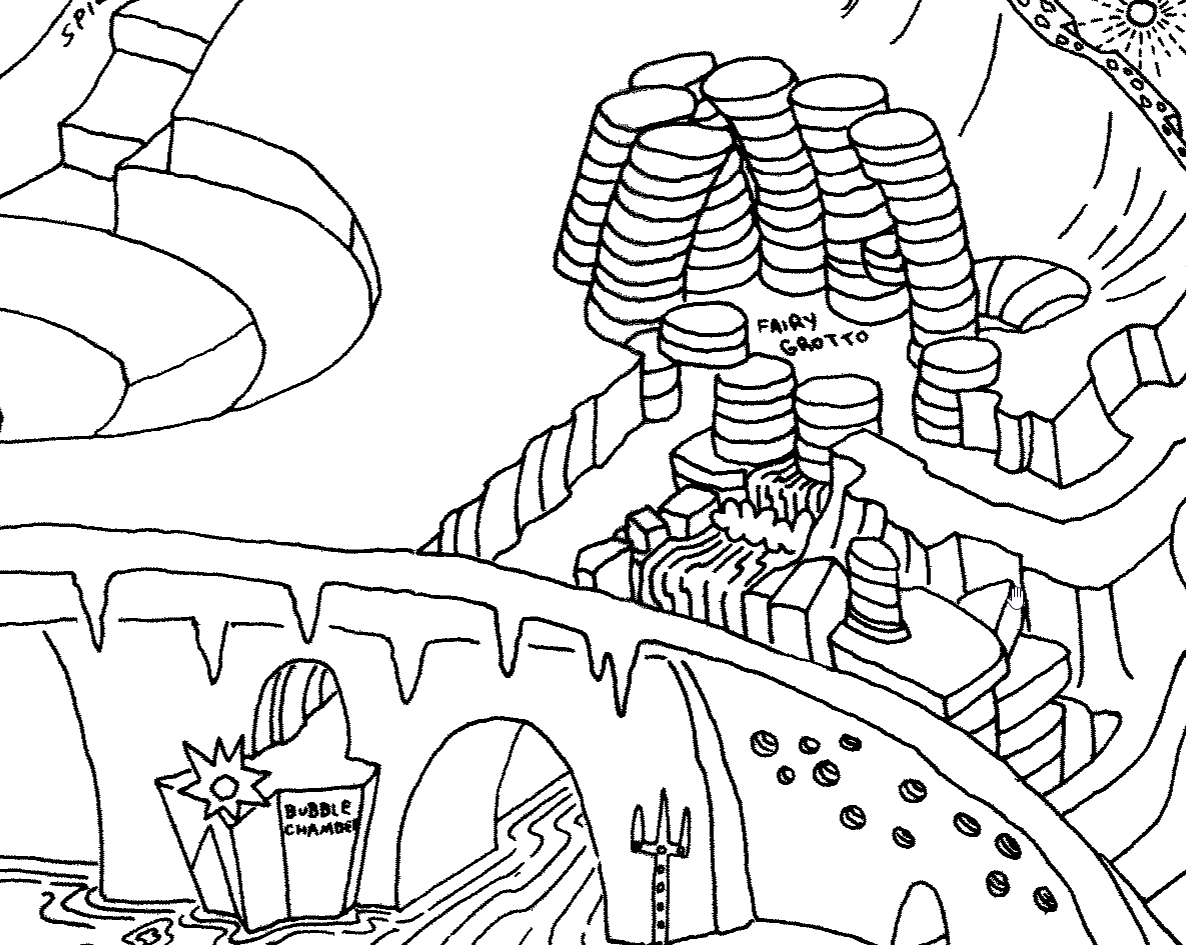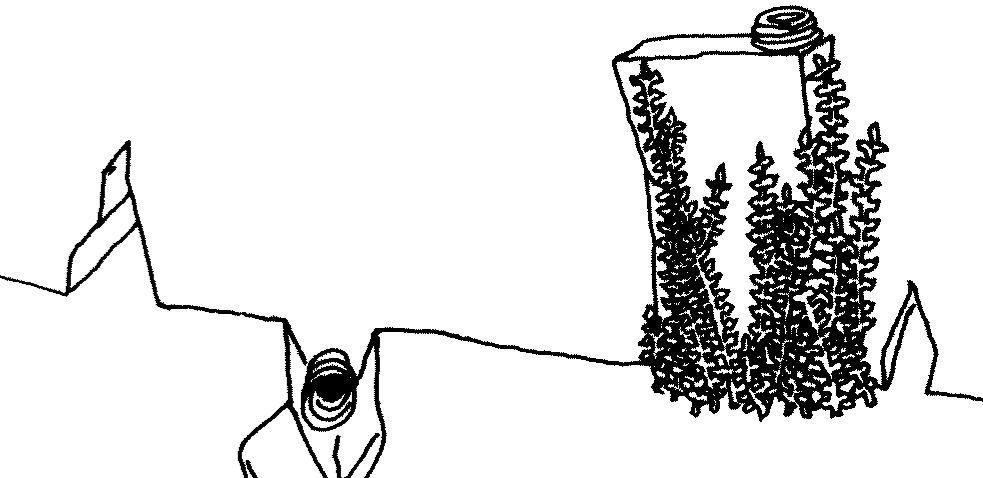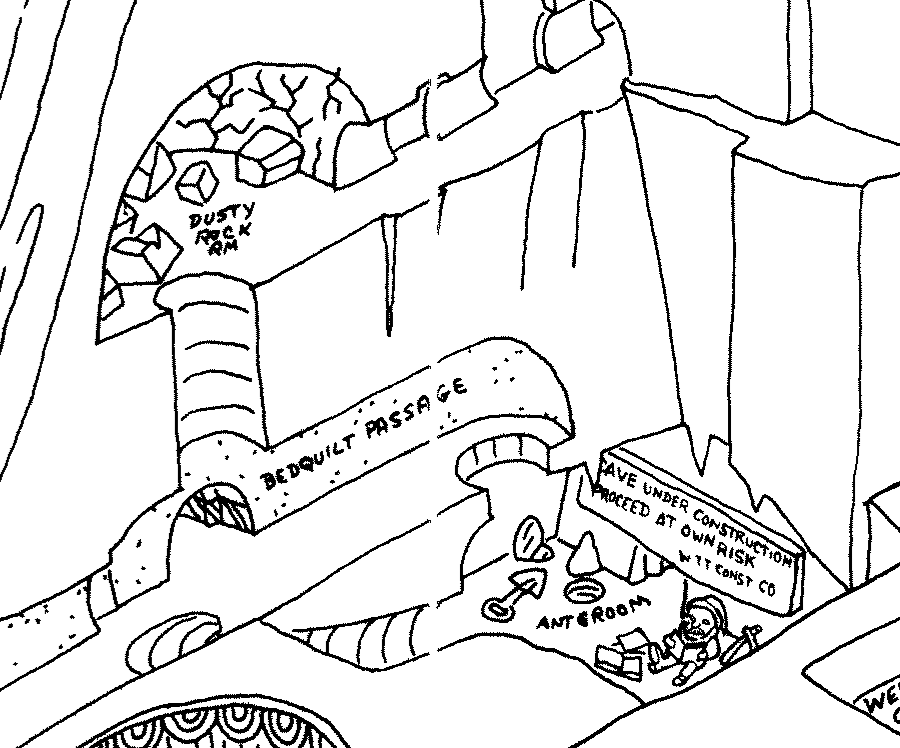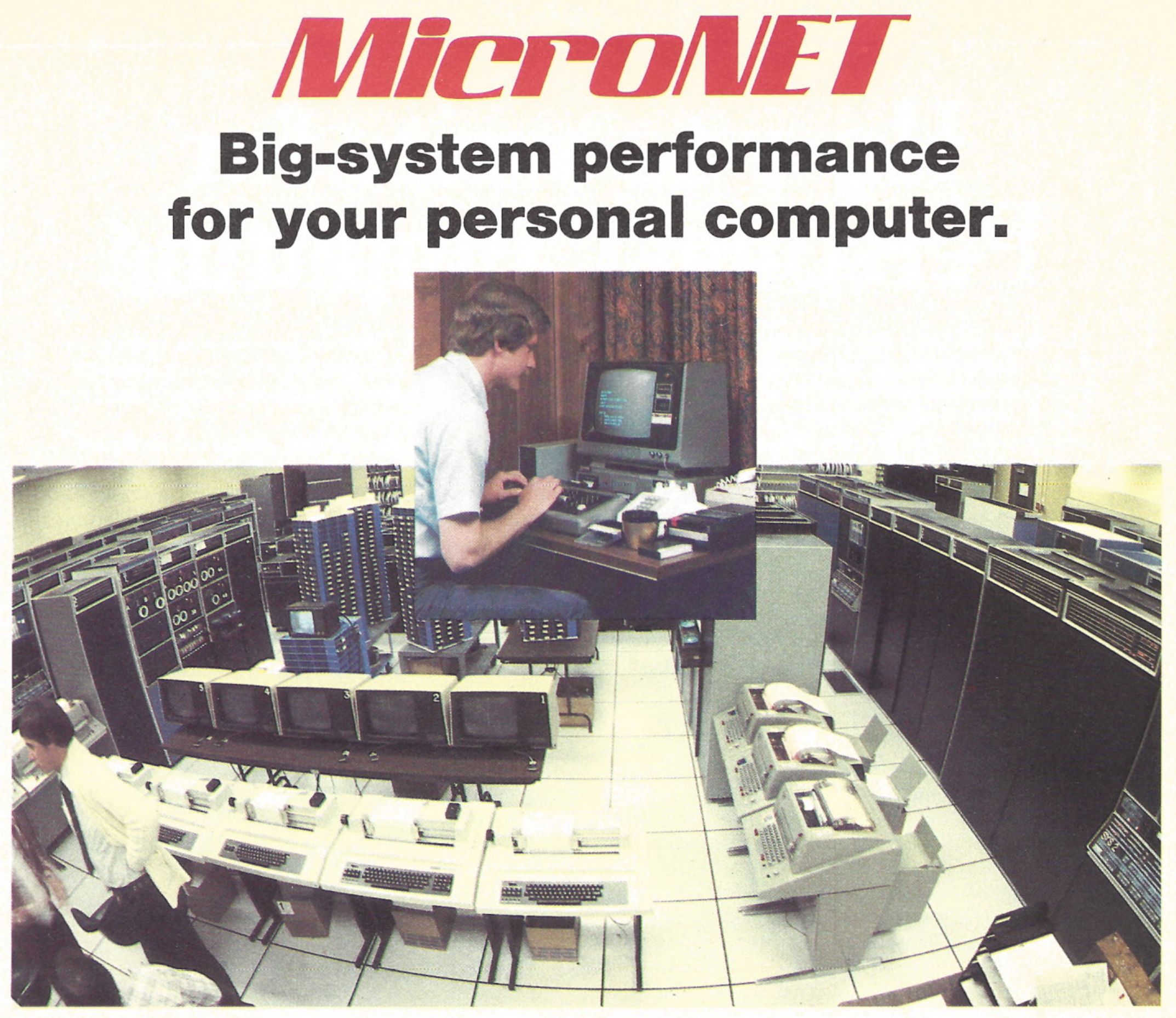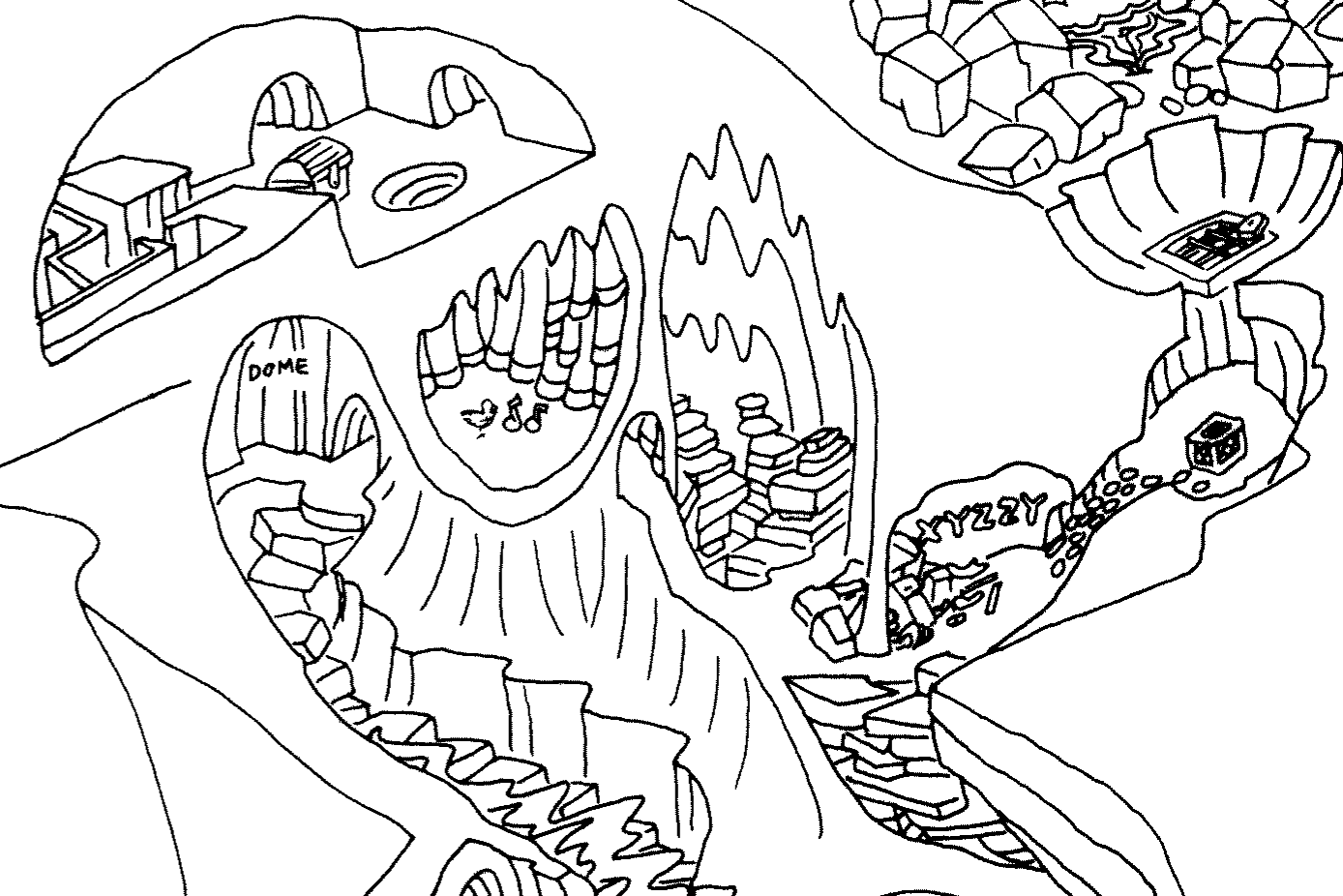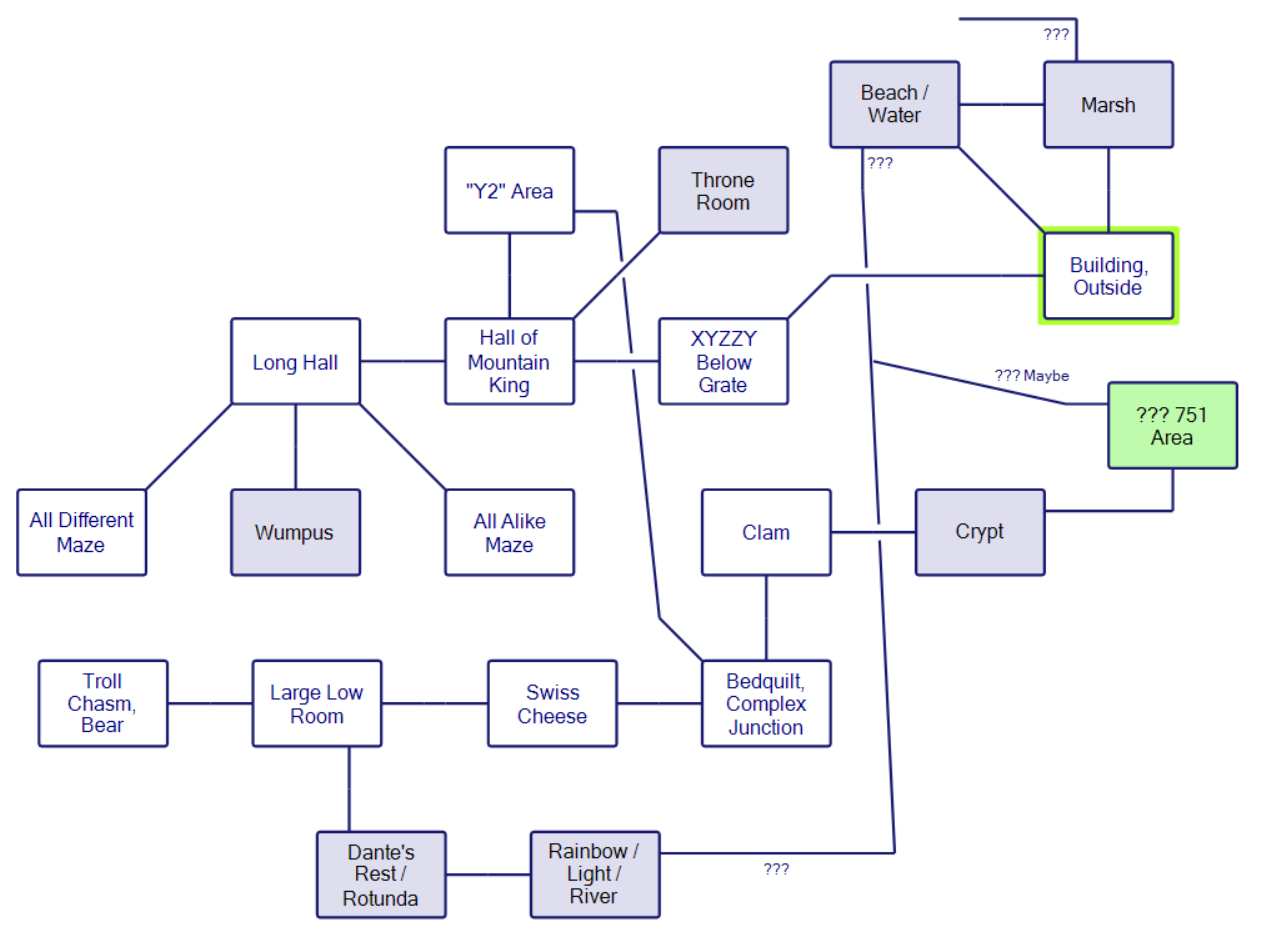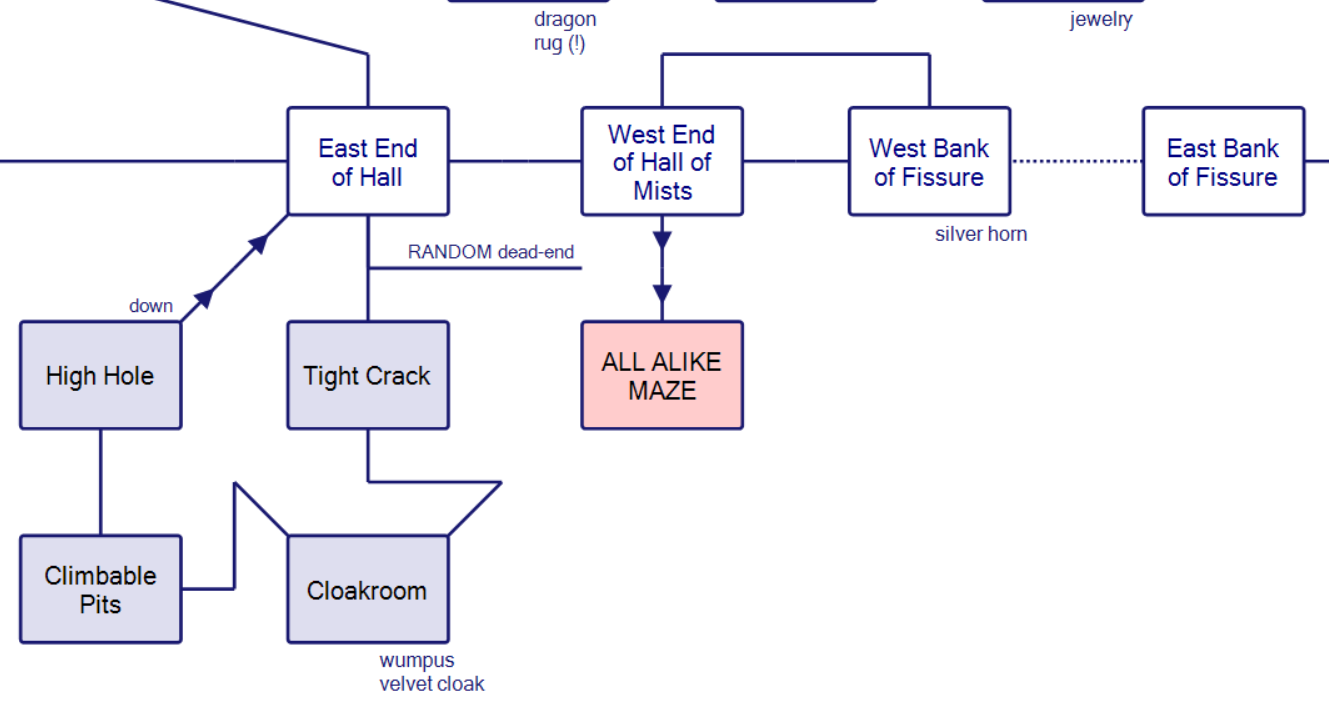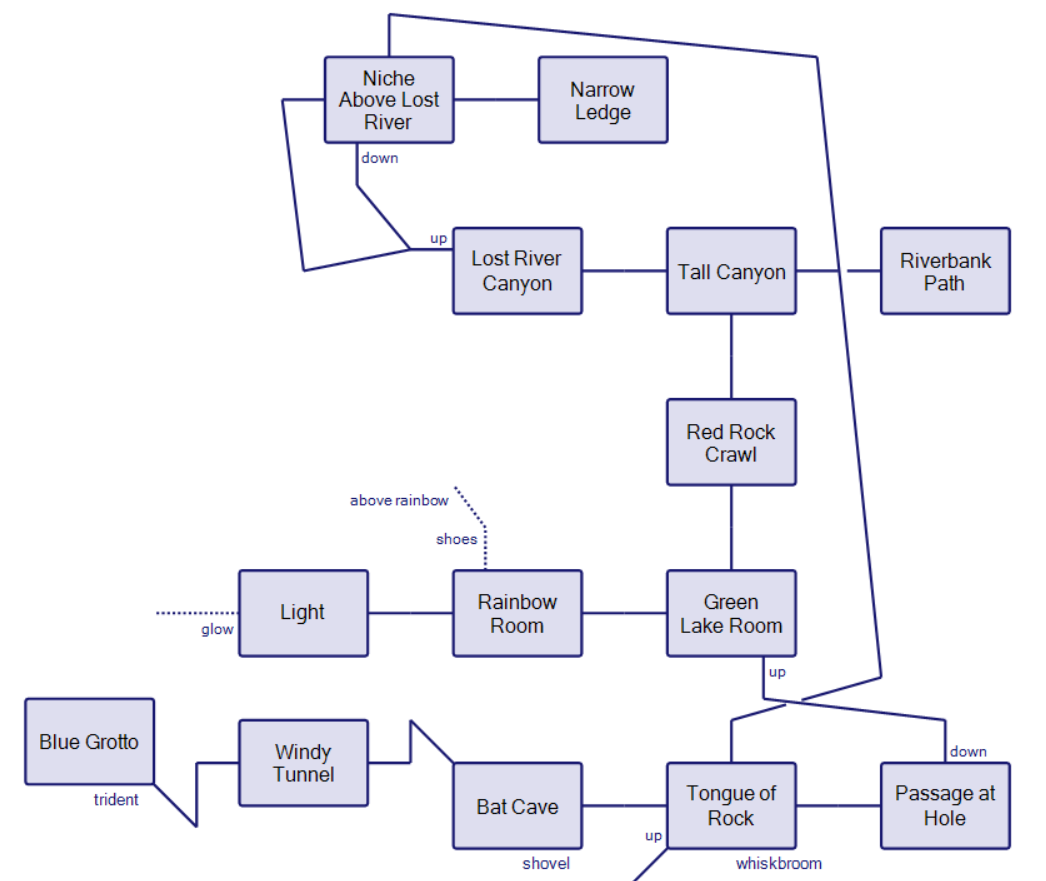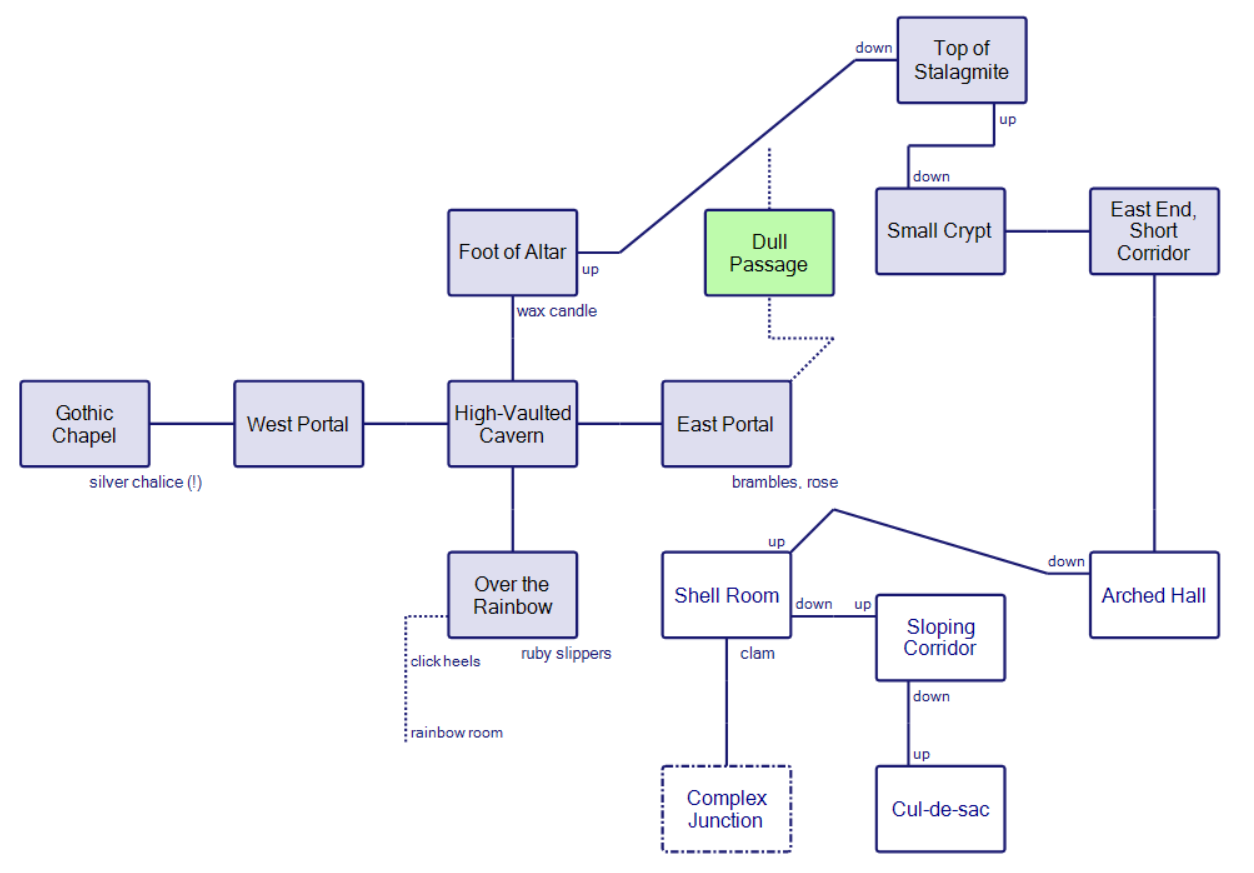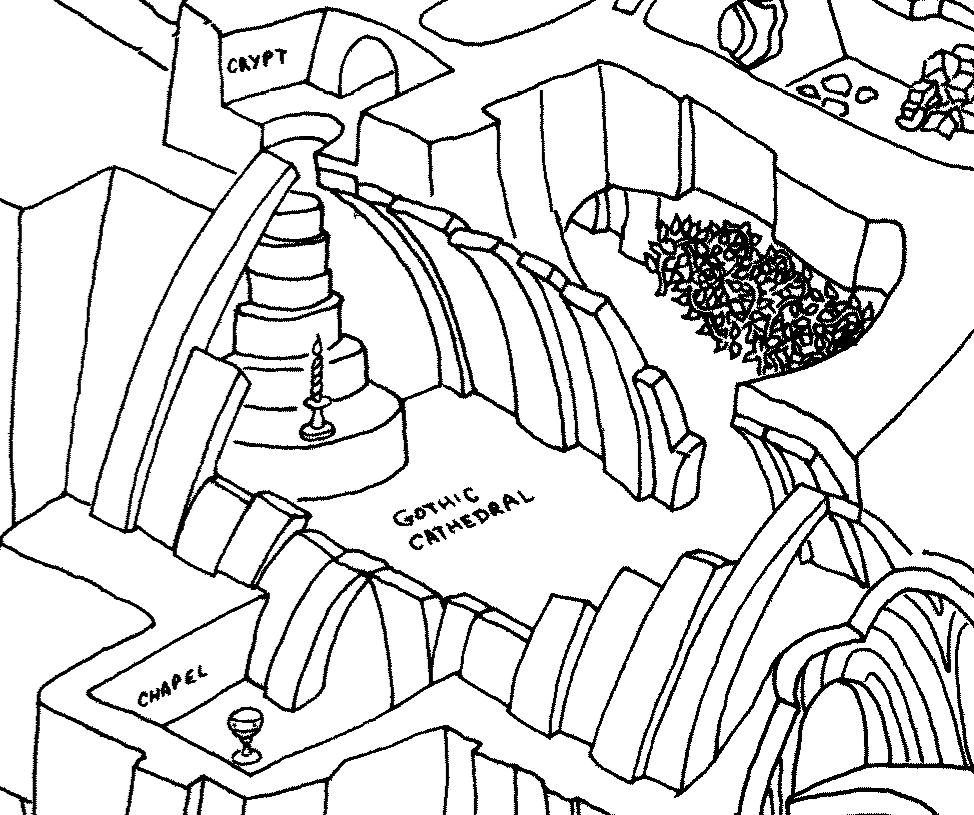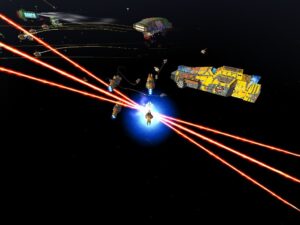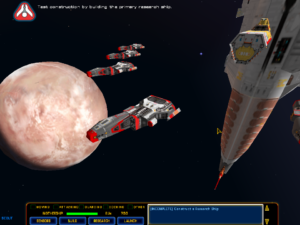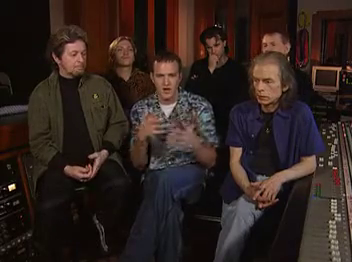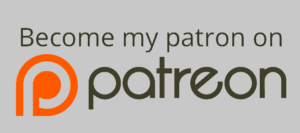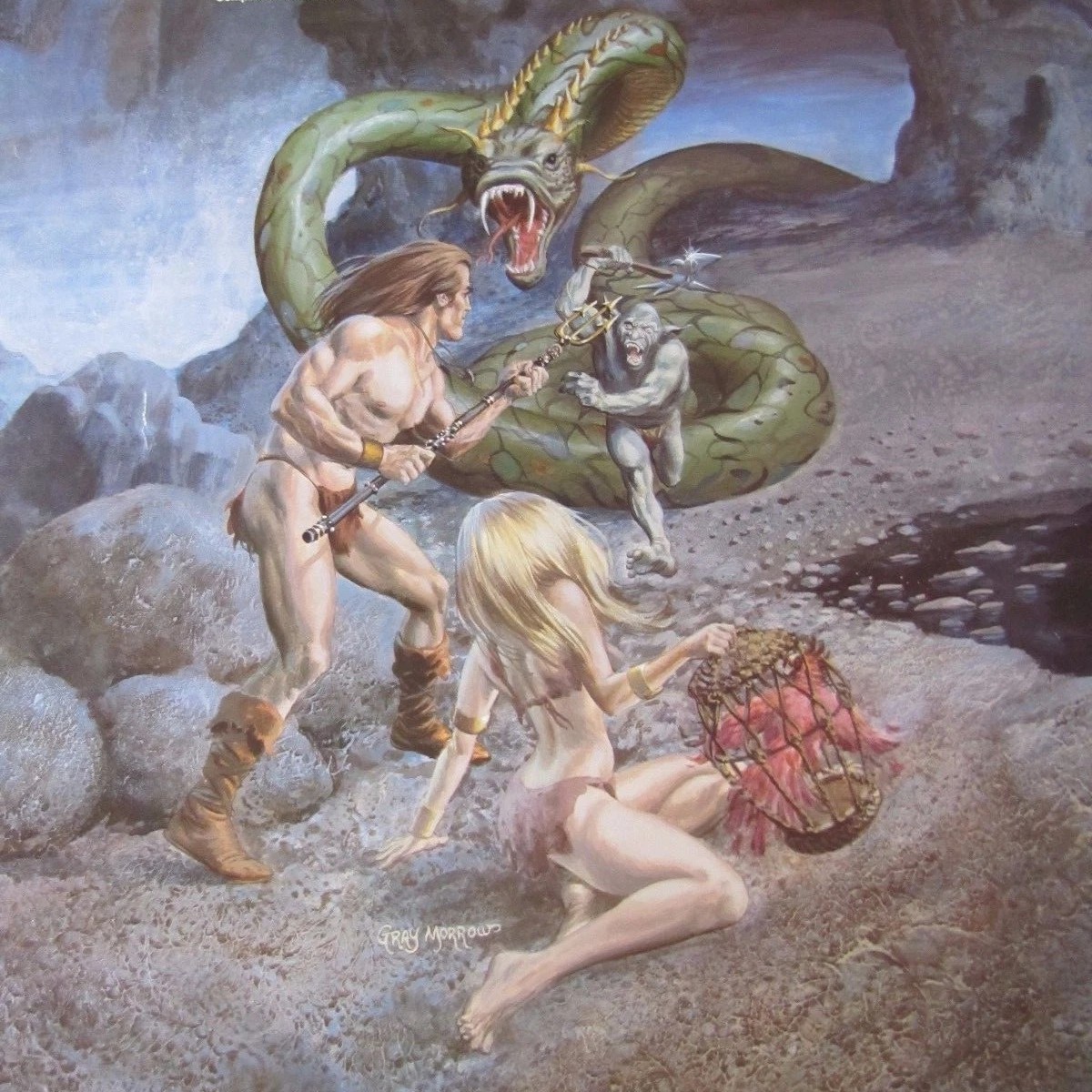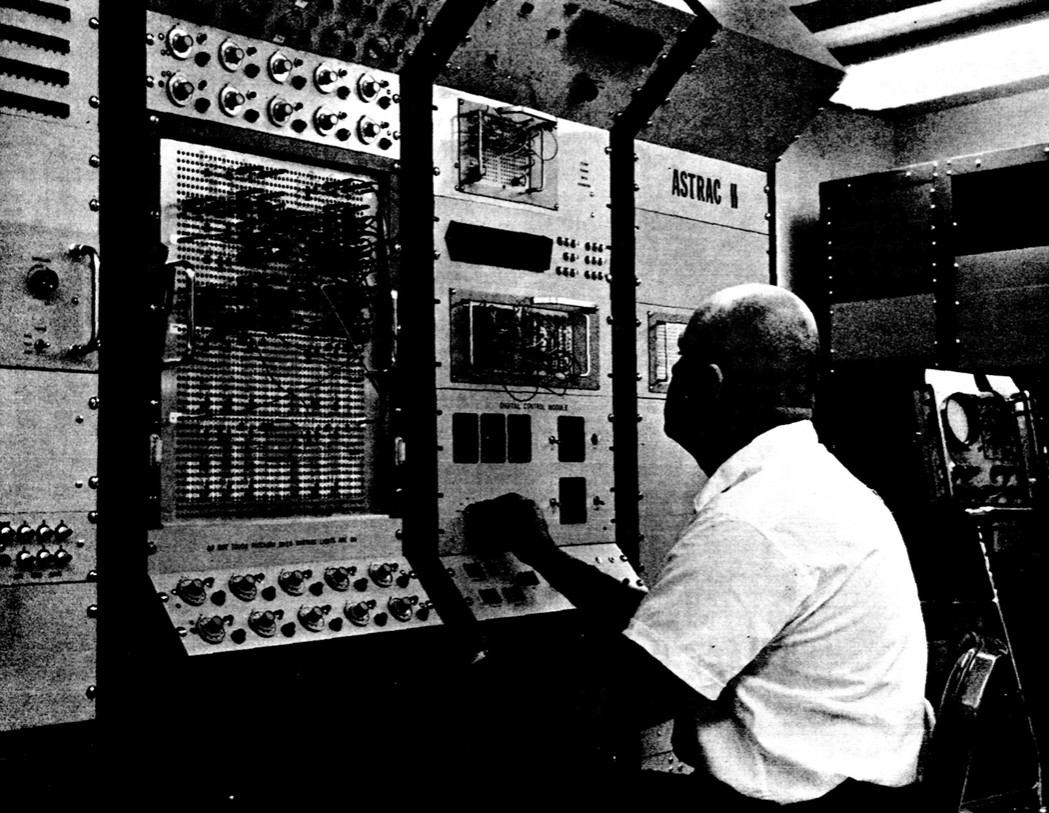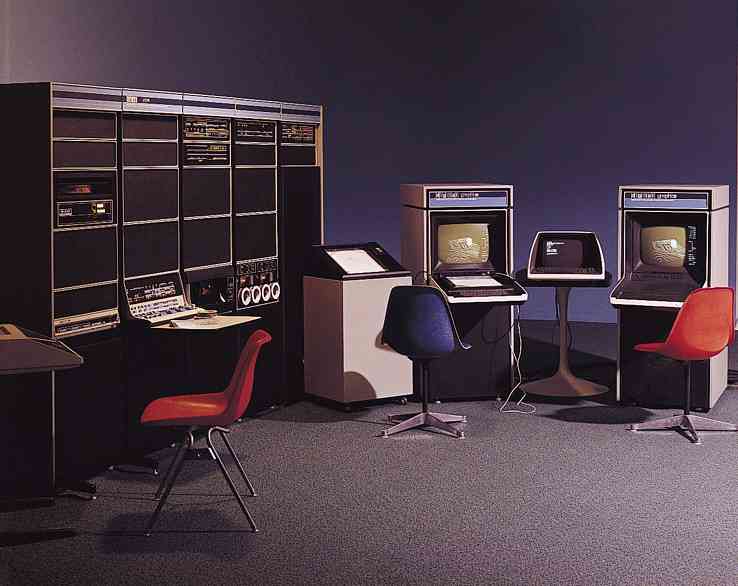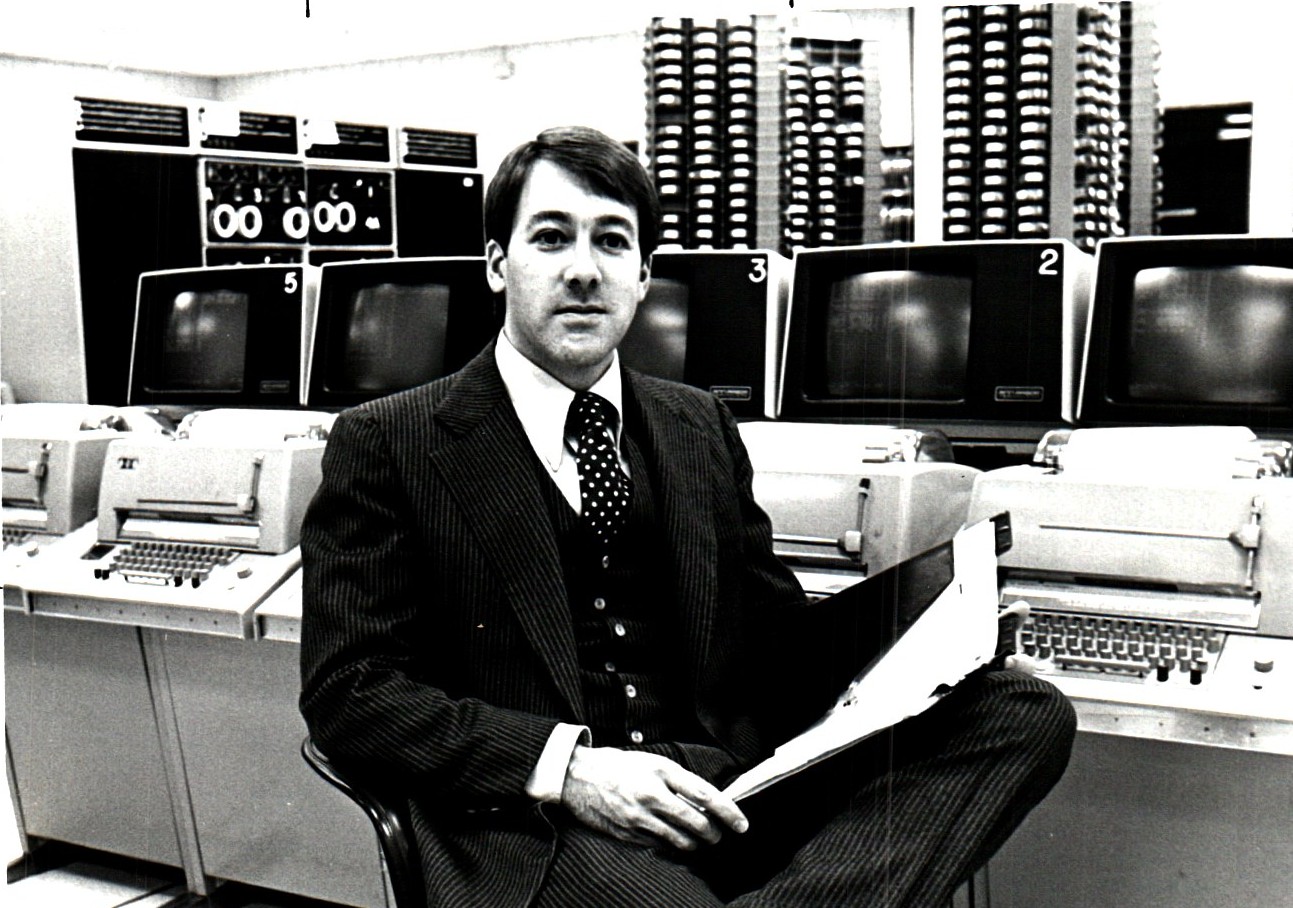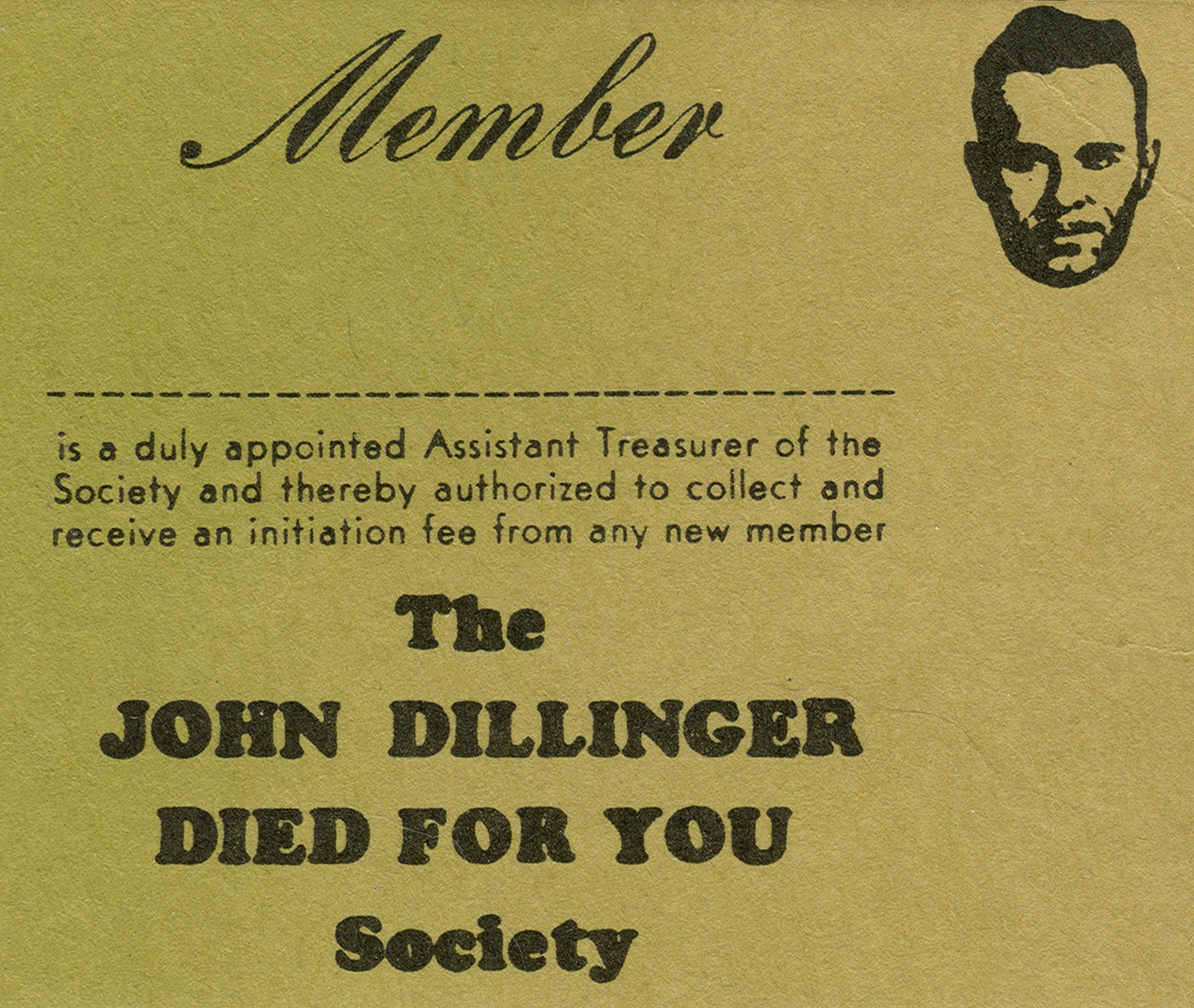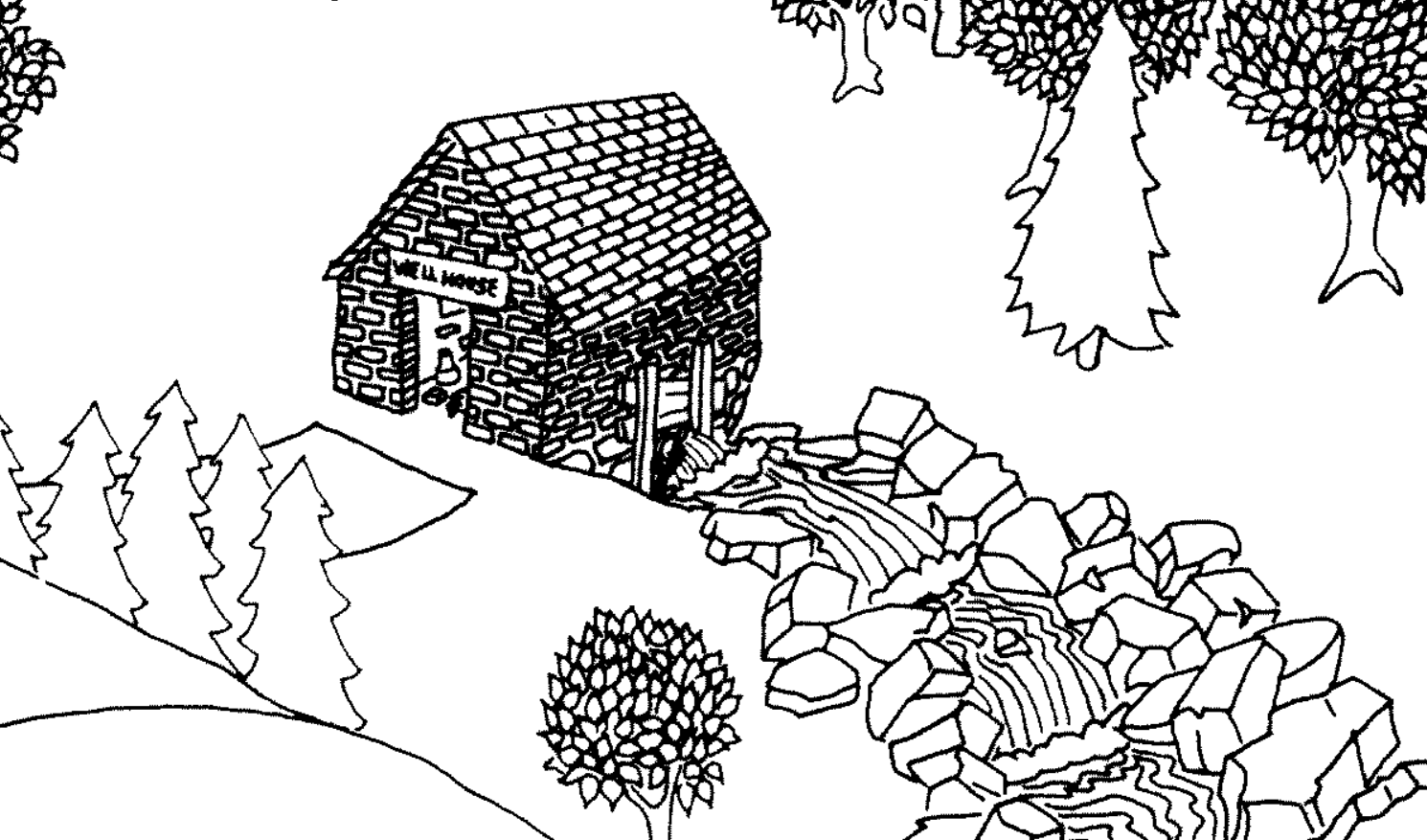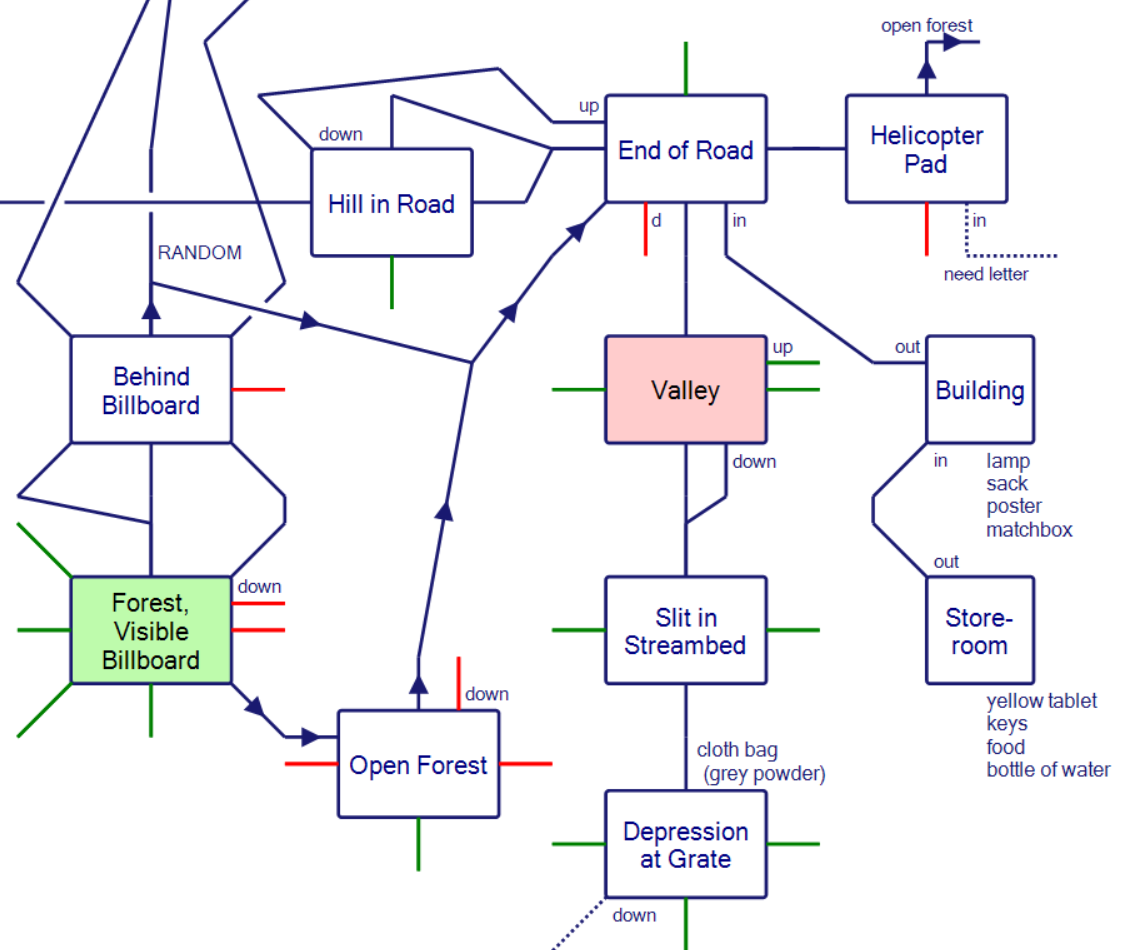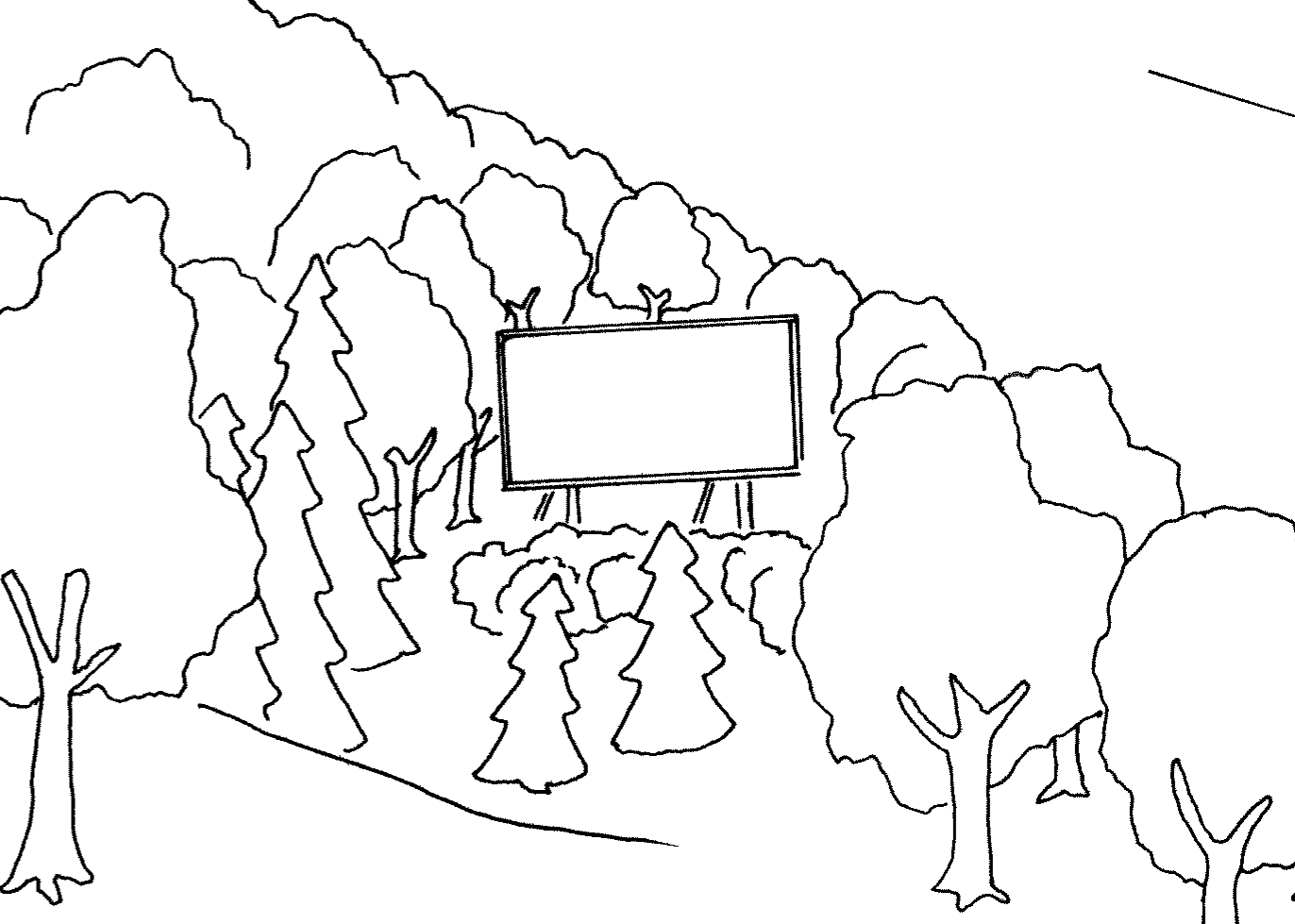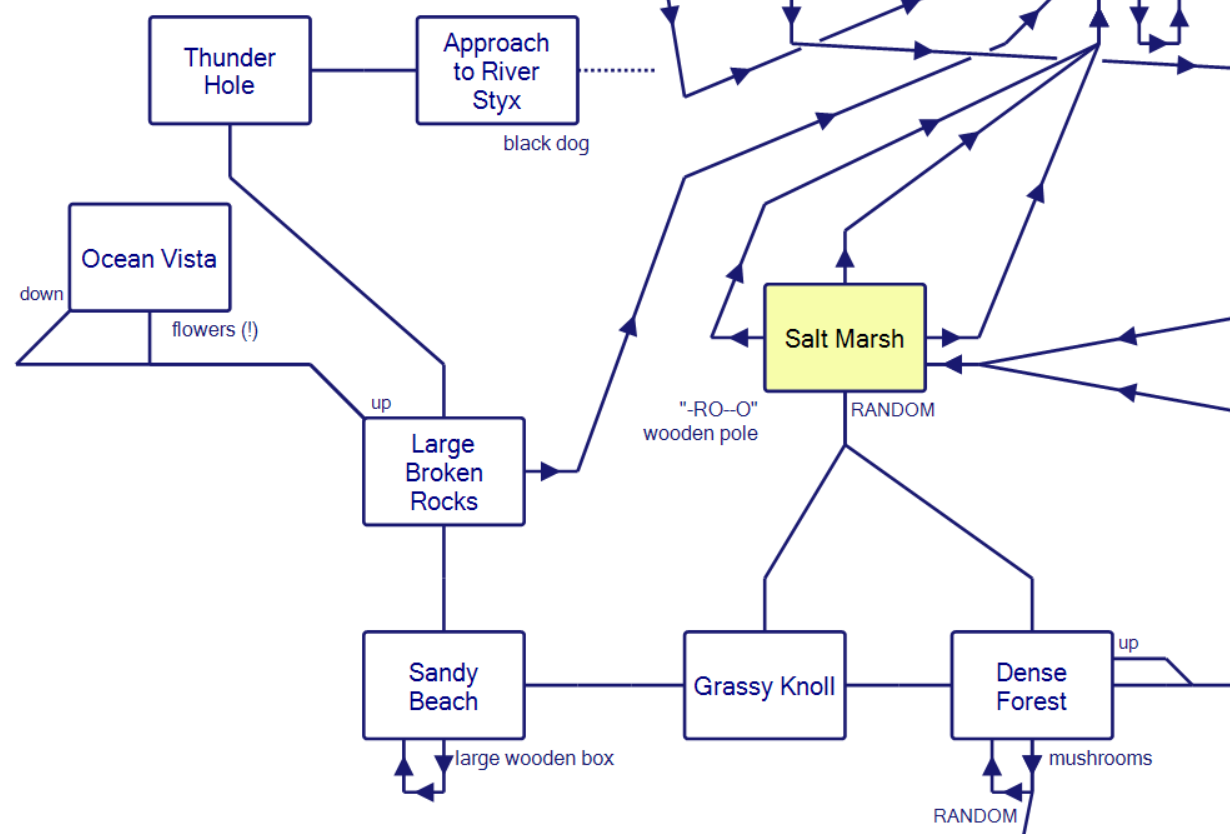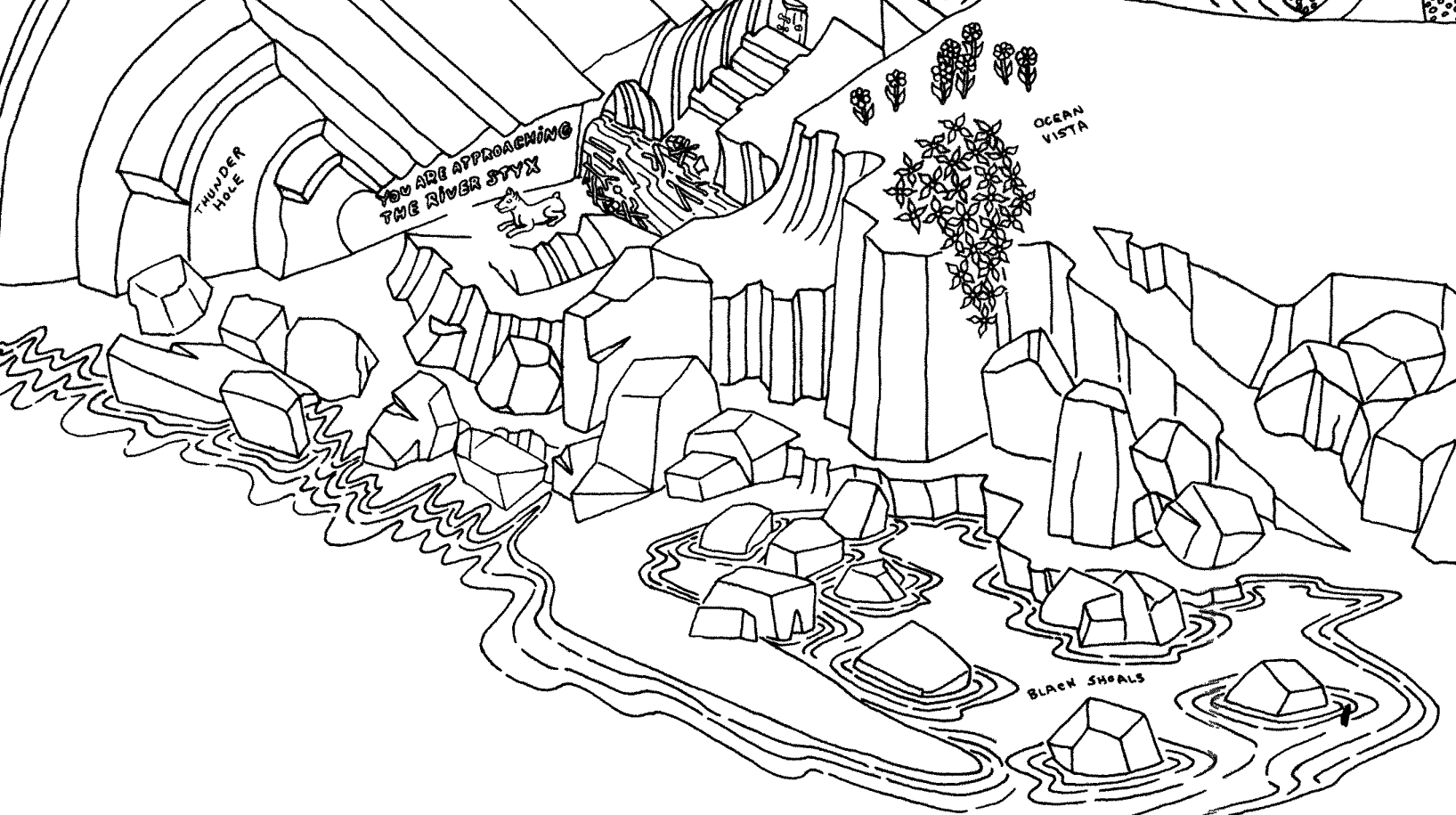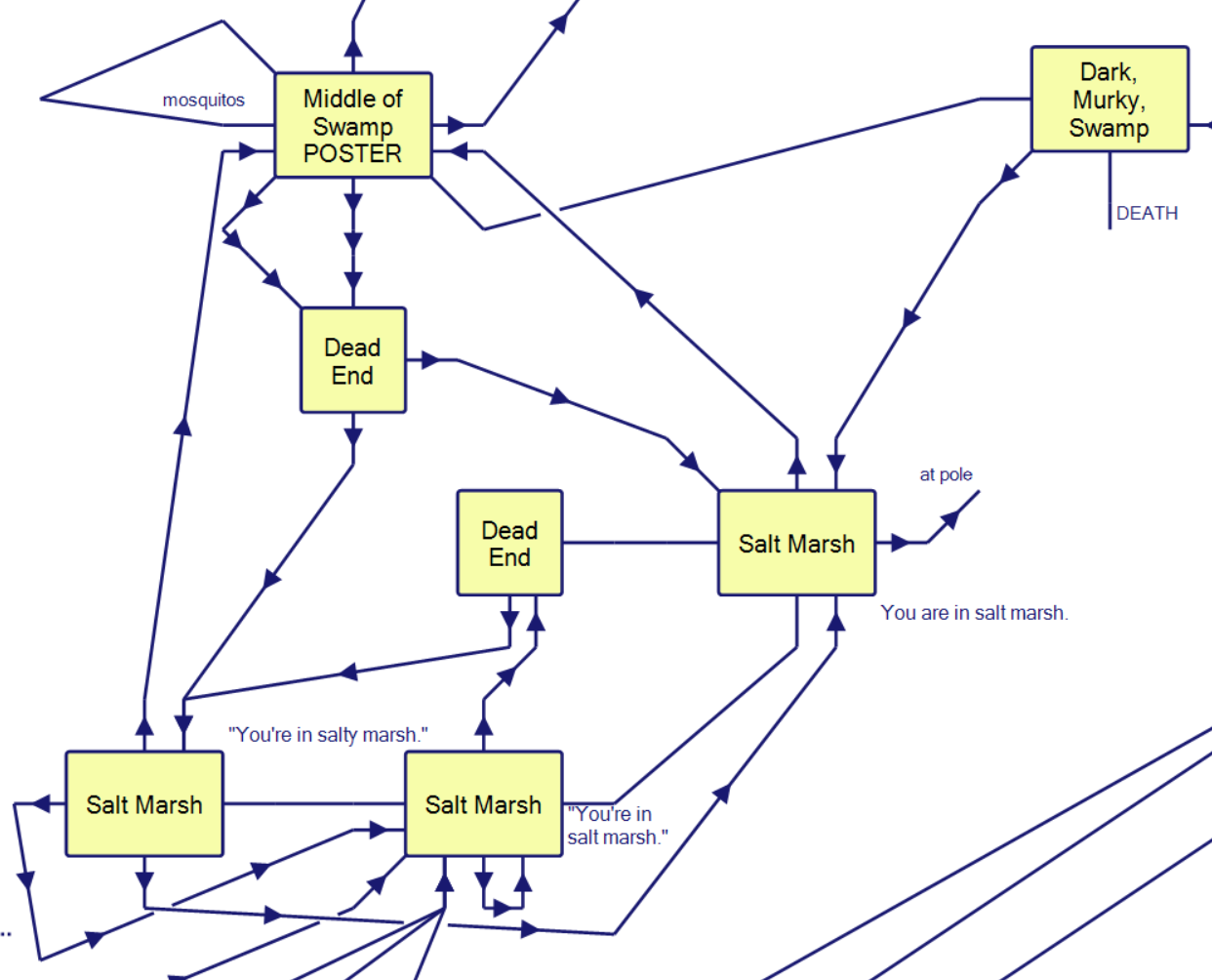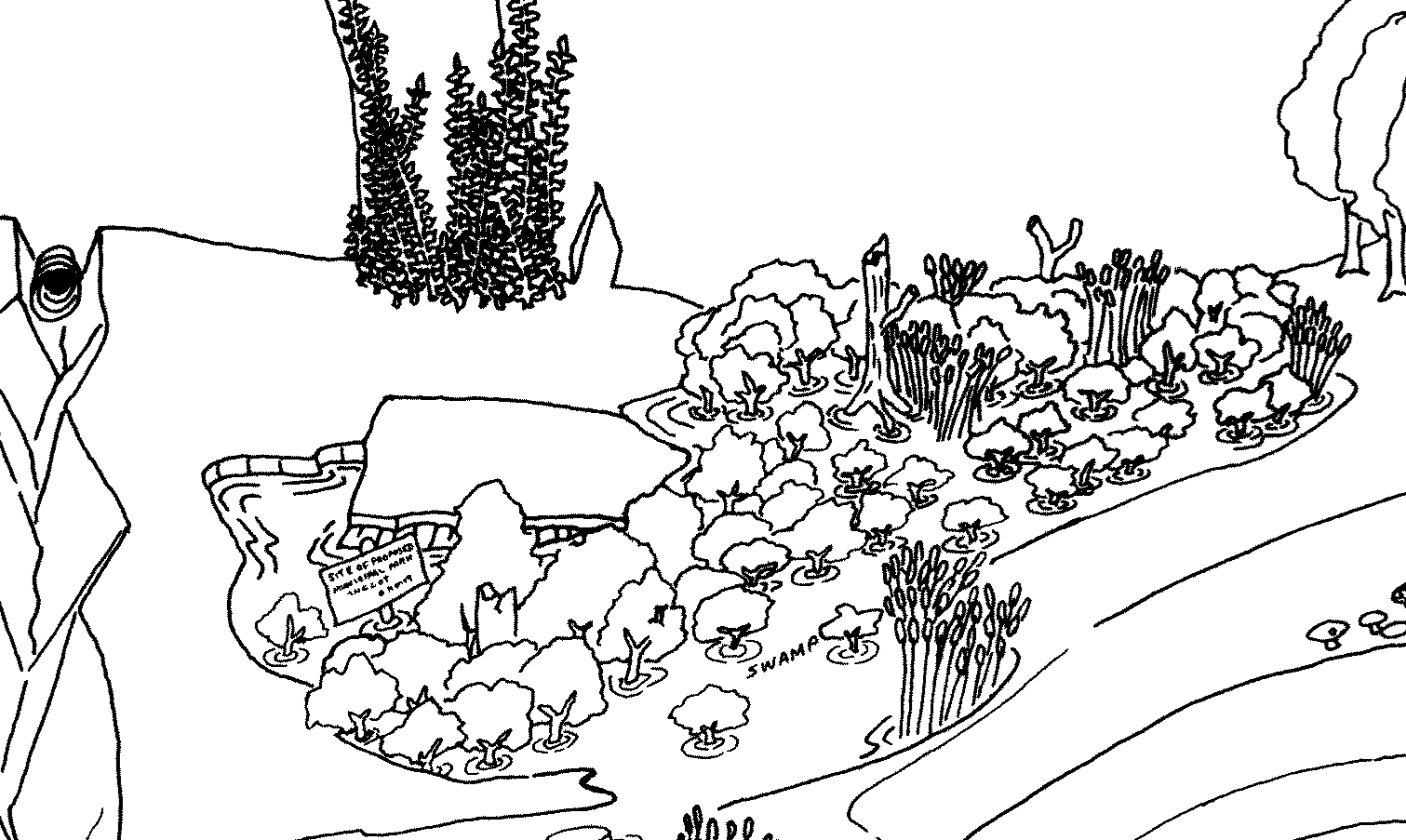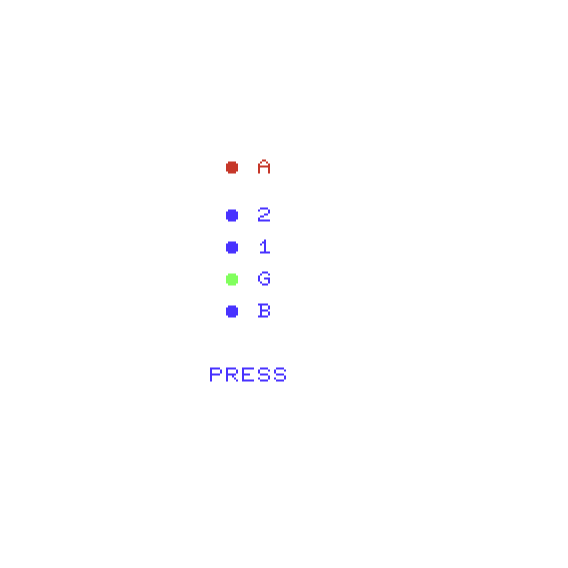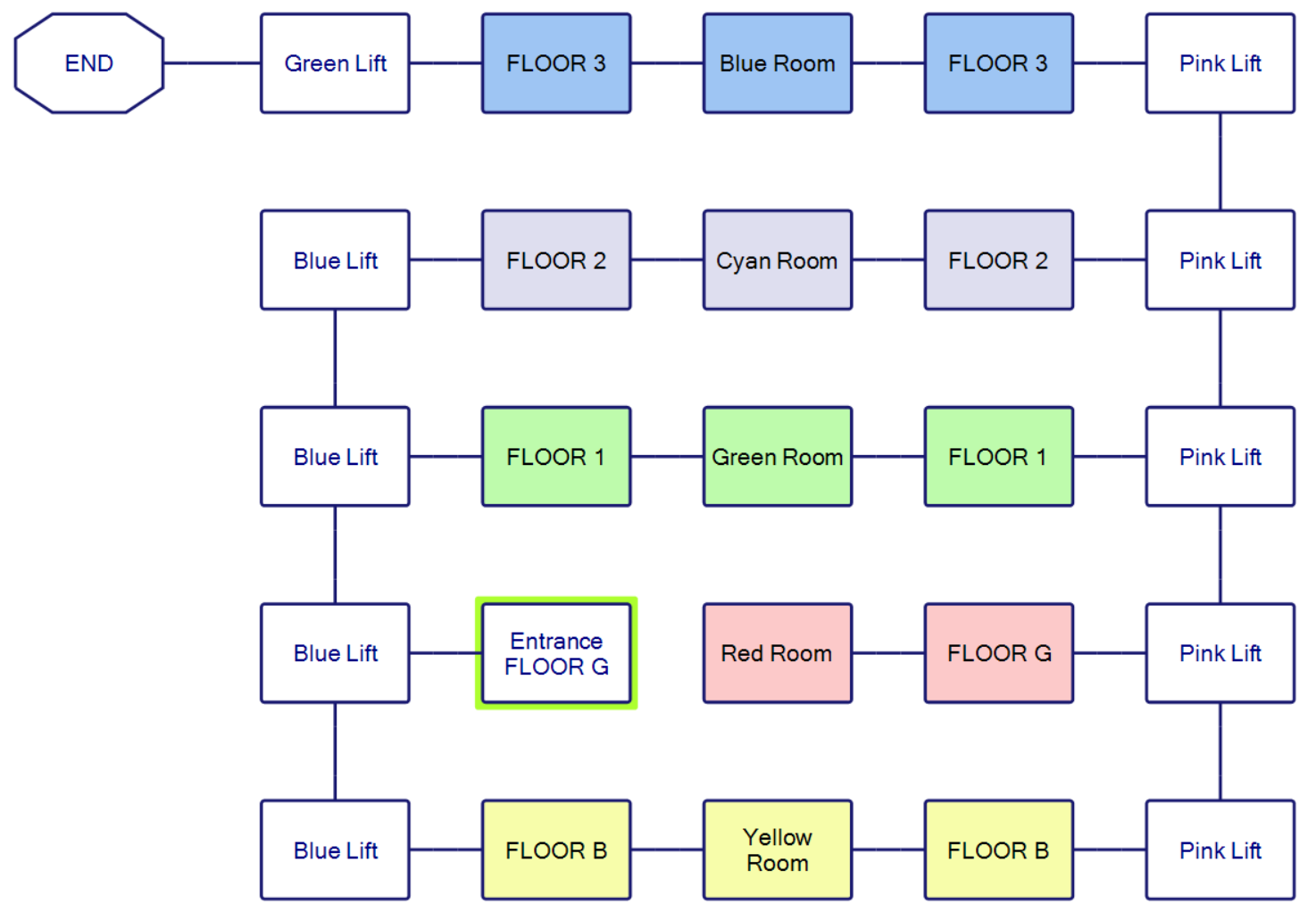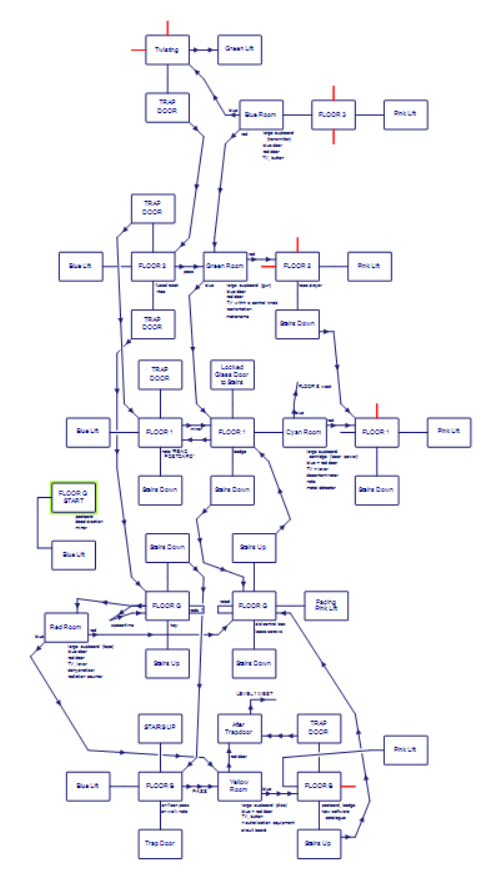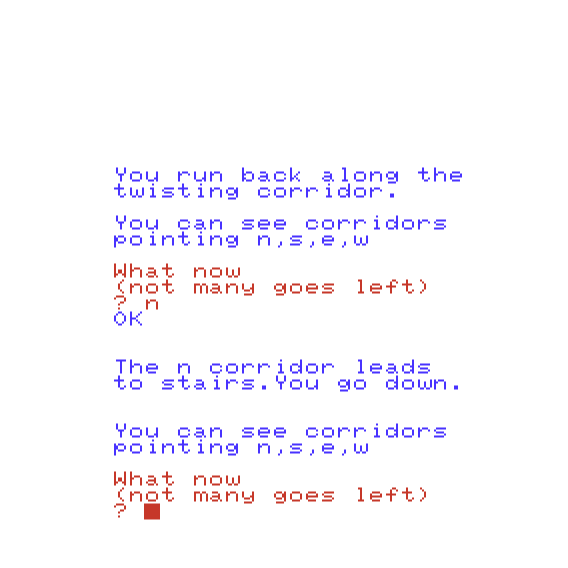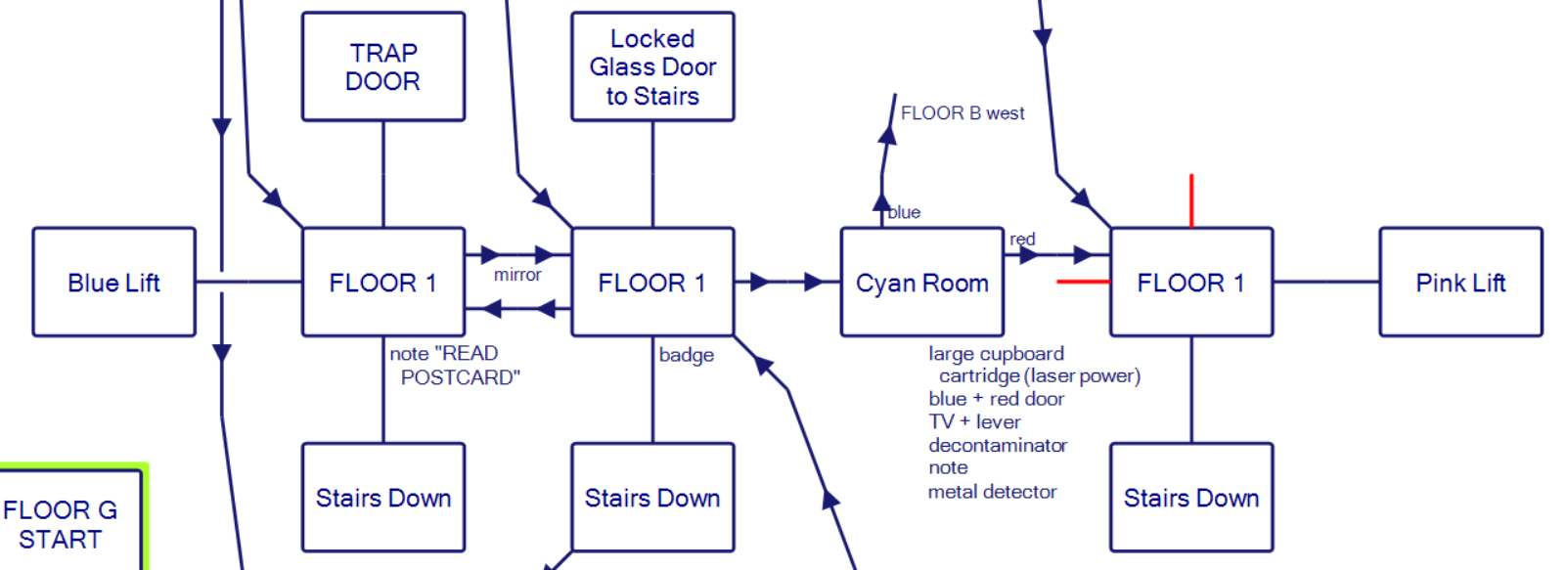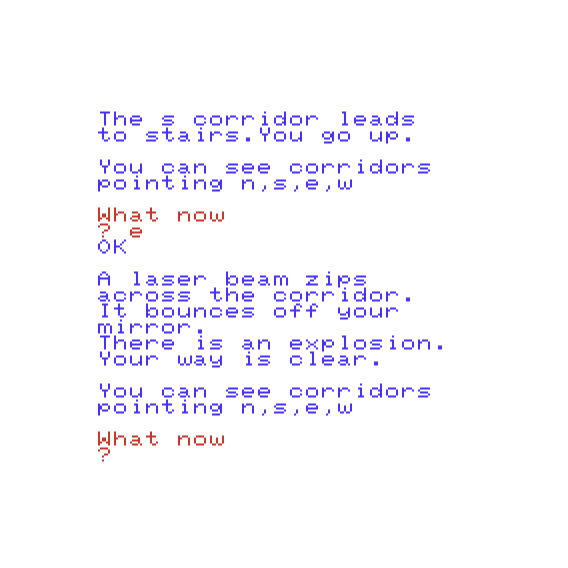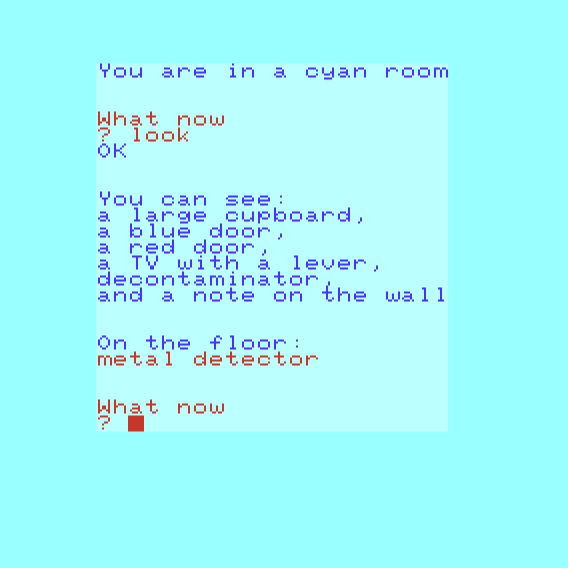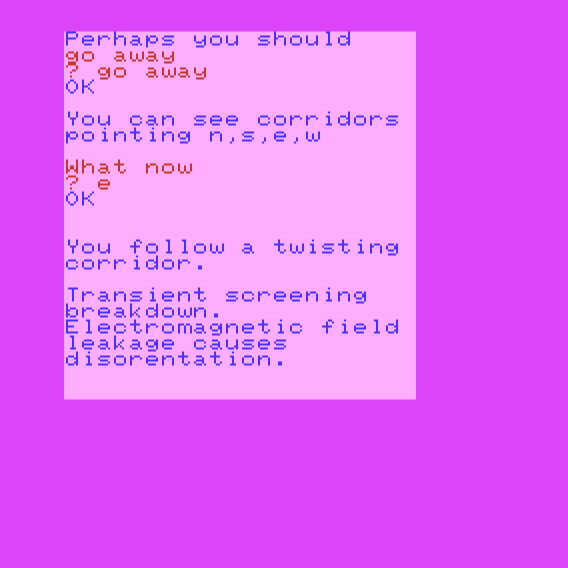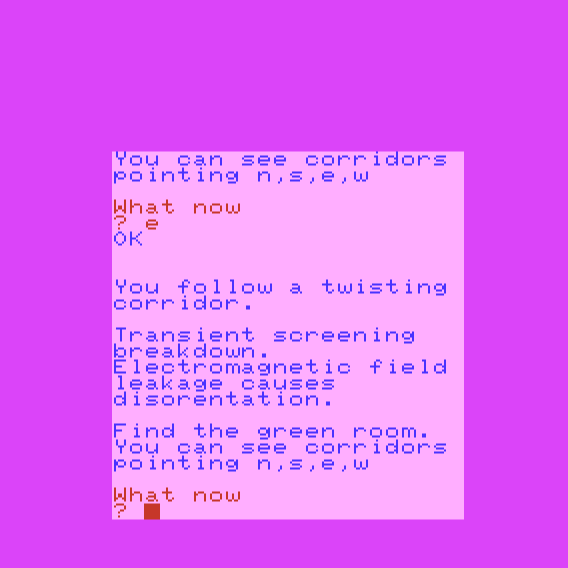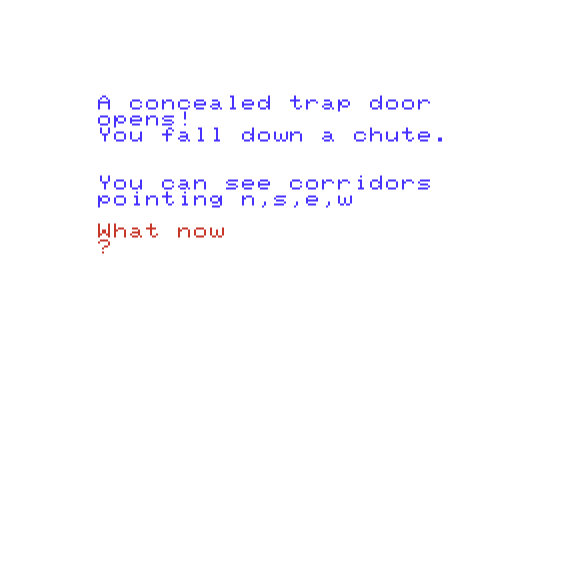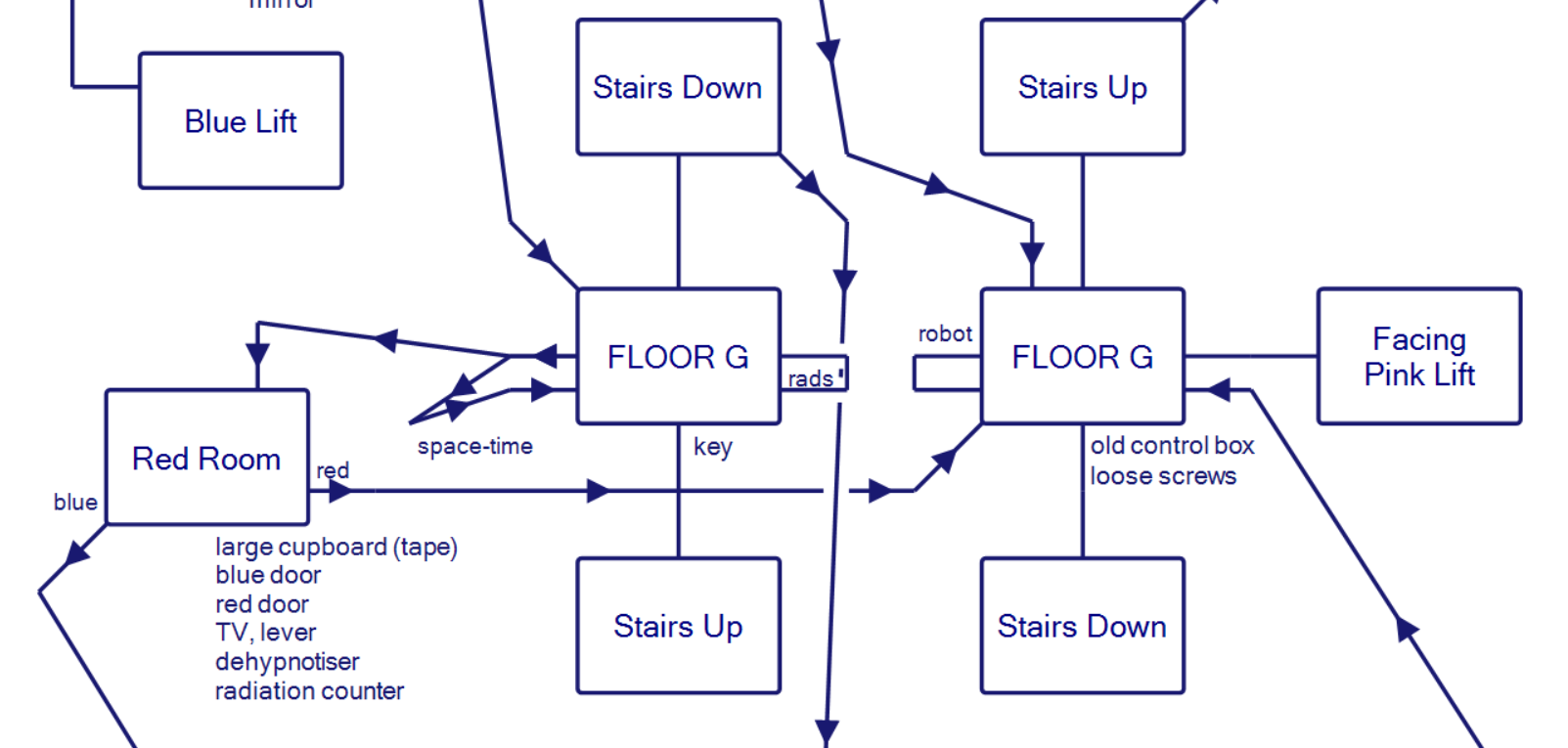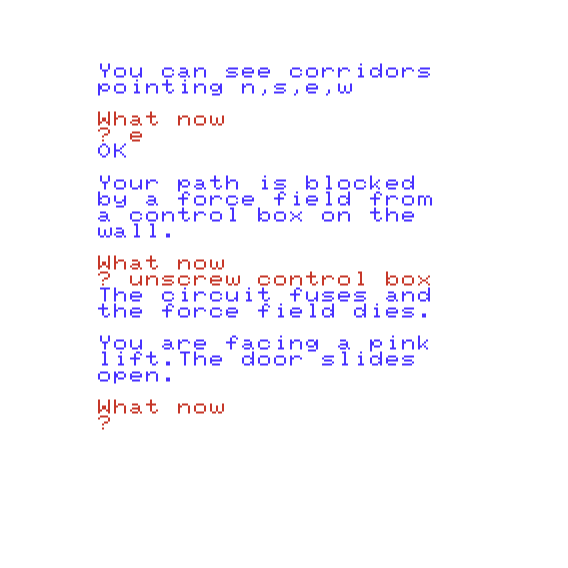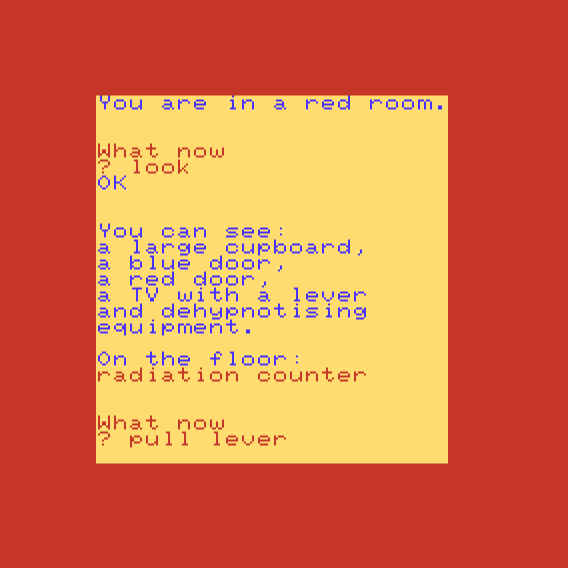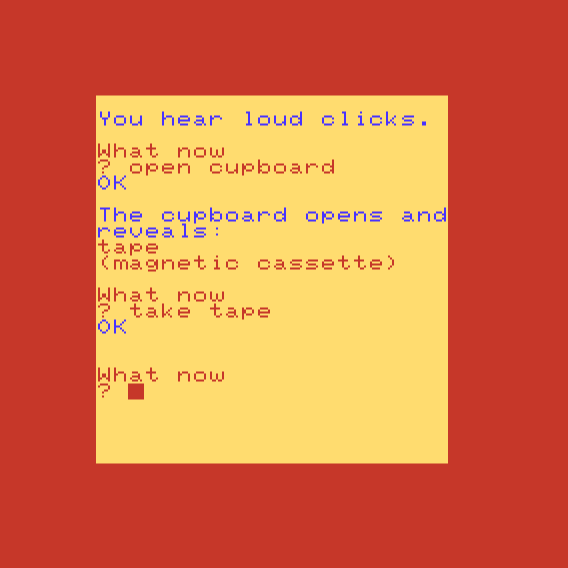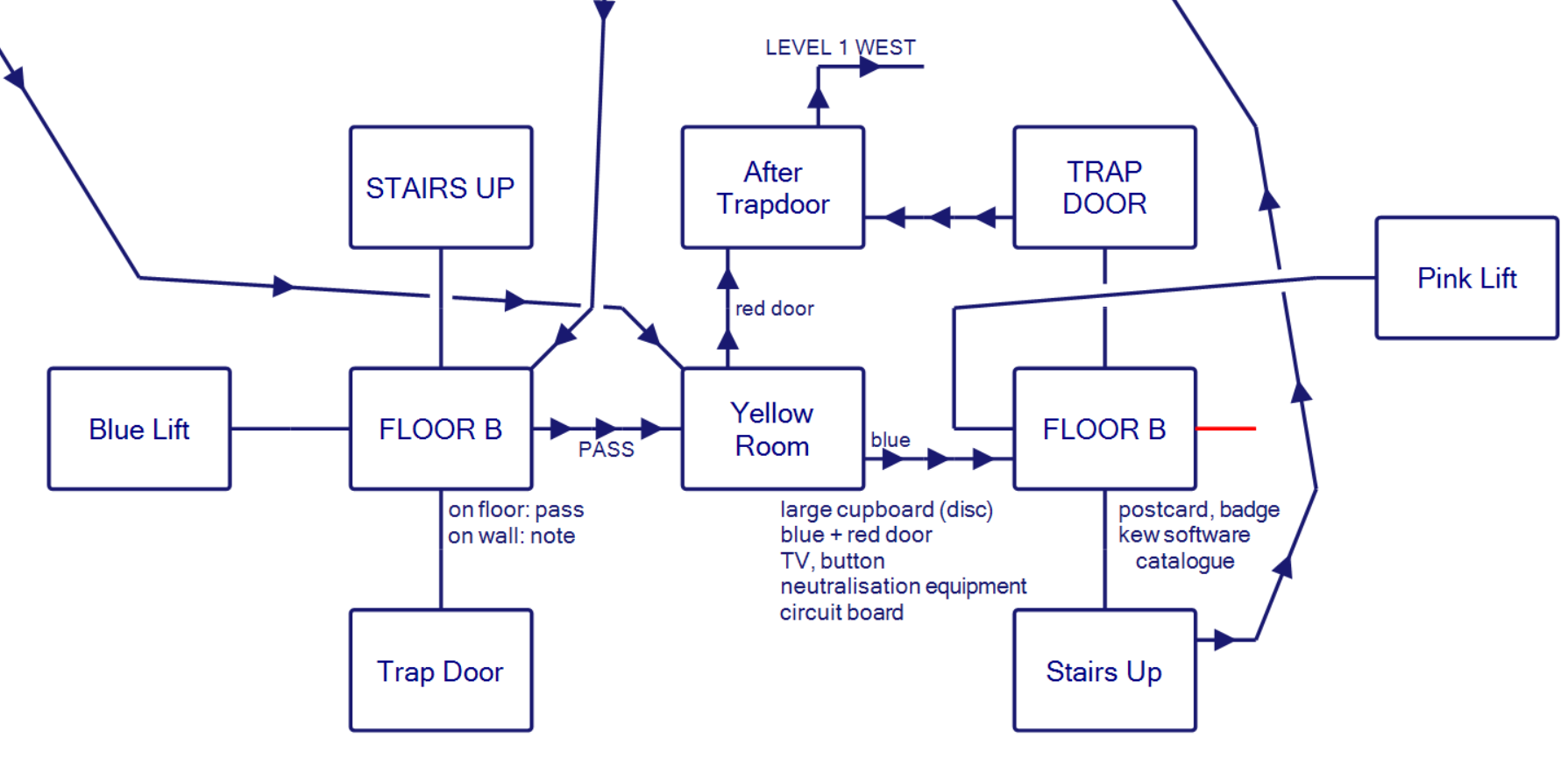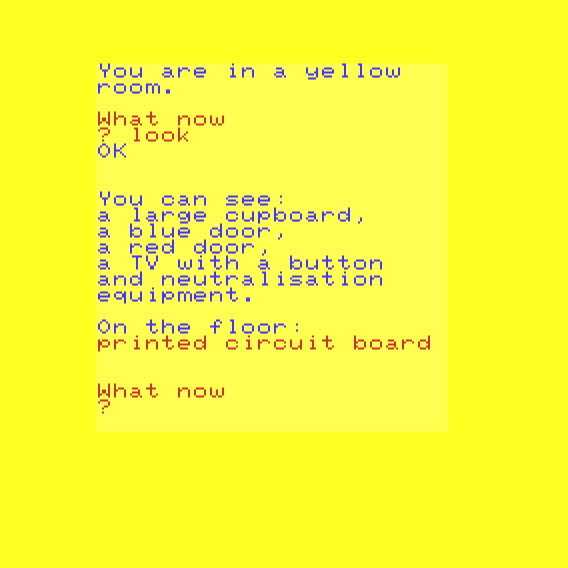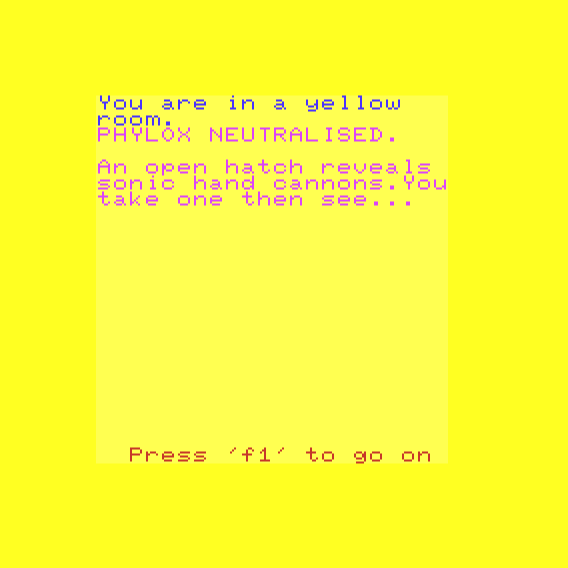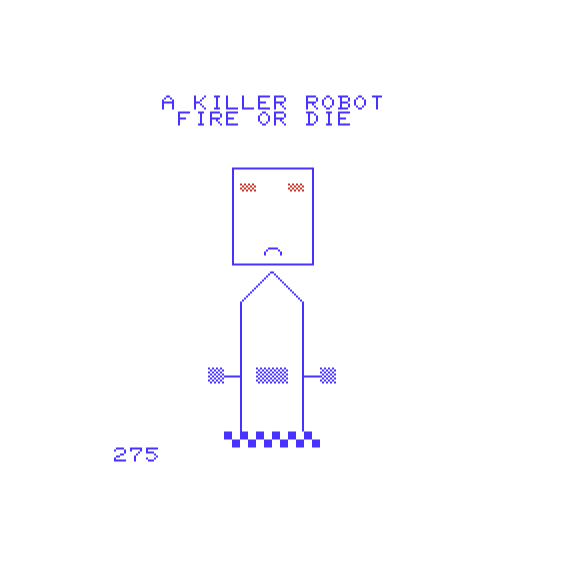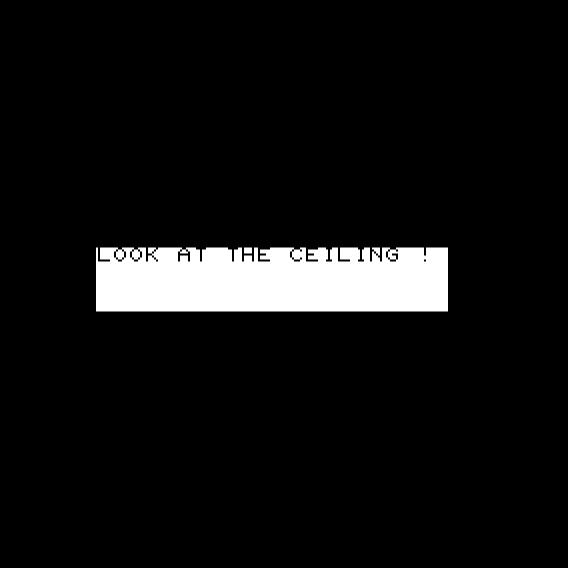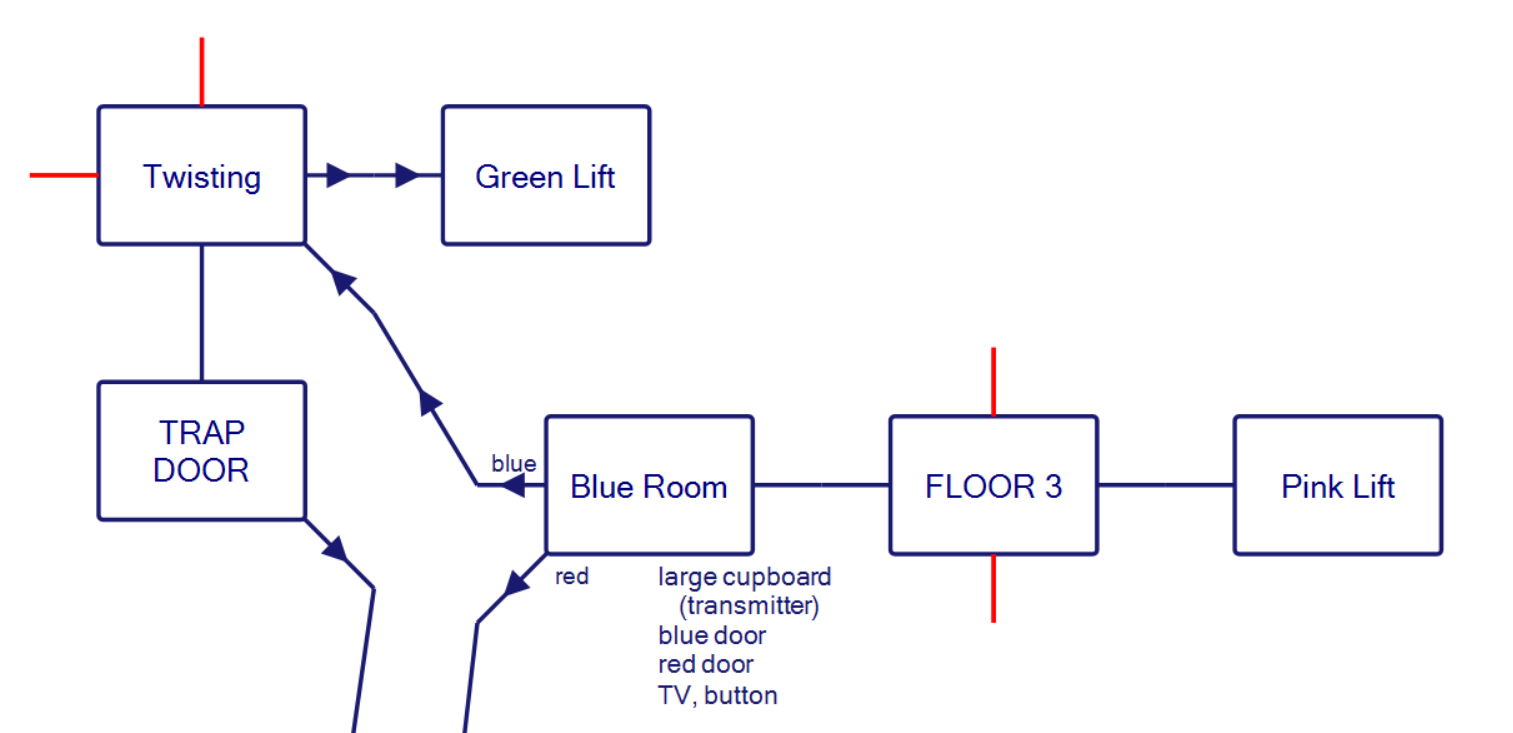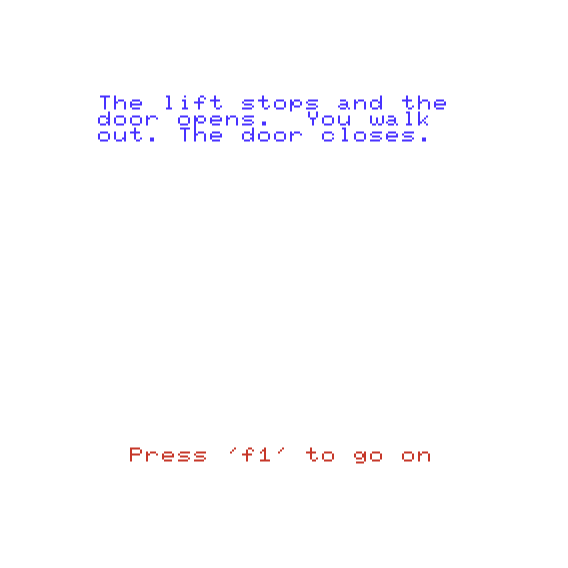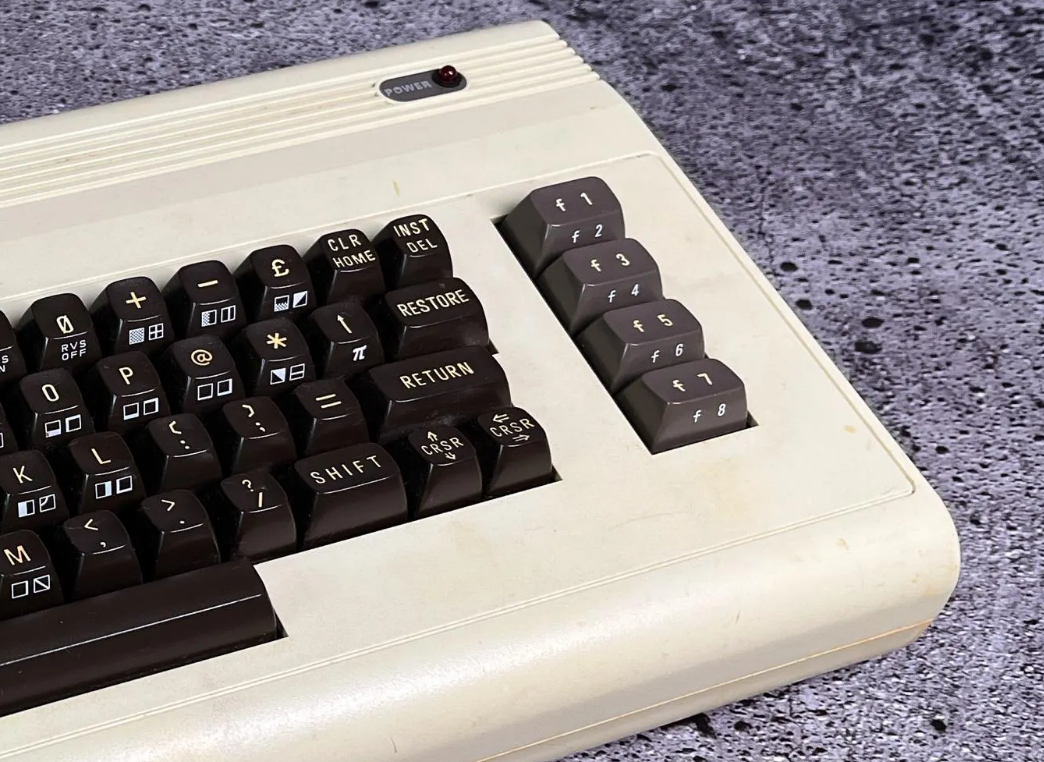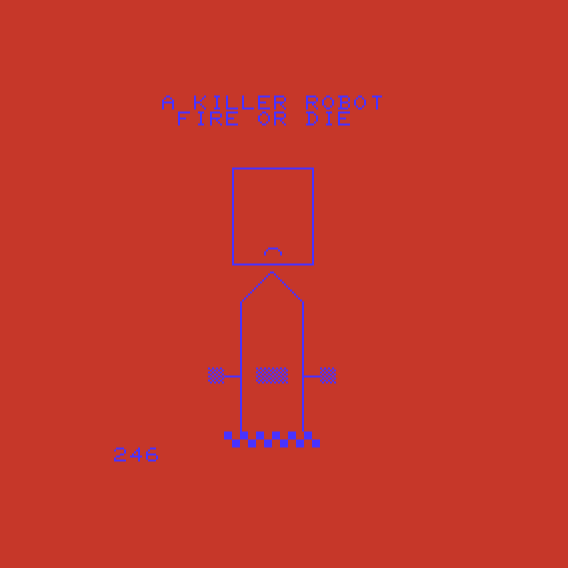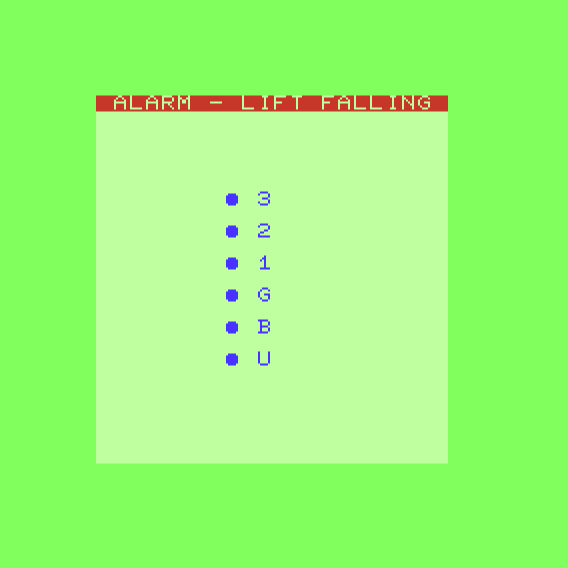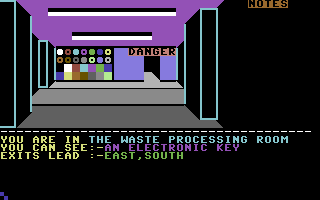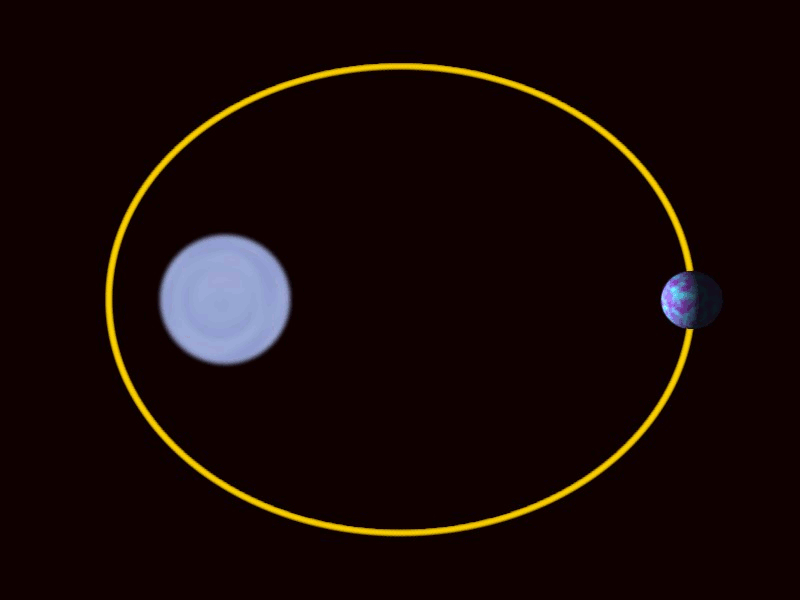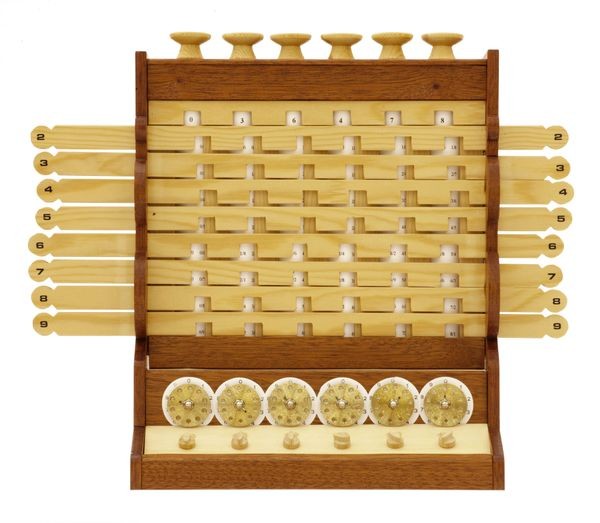After fighting the tendency for decades, I’ve finally learned to accept that I’m a bit of a conservative, if not a downright Luddite, when it comes to my interactive fiction — or my text adventures, as I still persist in calling them. Despite its name, parser-based interactive fiction doesn’t actually strike me as all that good at plot-heavy storytelling. What it does excel at is setting.
And this is just fine with me. Give me an interesting environment that I can sink my teeth into, filled with puzzles to solve and relations to tease out and exploit, and I’m all over it. Bigger is better here, as far as I’m concerned. I love a text adventure that I can live with for weeks or months, that I can leave open on a separate virtual desktop and let ruminate in the back of my mind while I’m doing other things, popping into it from time to time to try out a brainstorm or add another few rooms to the steadily expanding map of the world that I keep open in another window. Other people use Tetris as a mental palate-cleanser; I use The Mulldoon Legacy. What can I say? As you readers must surely have recognized by now, I’m kind of a weirdo.
Unfortunately for me, by the end of the 1990s, the types of text adventures I like best were beginning to fall out of favor with the post-commercial interactive-fiction community. Amidst much excitement over the newly “literary” paths the medium was blazing, a background chorus of atavistic throwbacks just like me bemoaned the dwindling number of new big games. The annual Interactive Fiction Competition, which at that time strongly encouraged its authors to limit themselves to games that could be played to completion in two hours or less, was widely blamed for the drift toward snacks instead of full meals. There is undoubtedly a lot of truth to this, but to that truth must also be added the simple reality that making a big text adventure is hard, and by this point there had long since ceased to be any tangible reward in it beyond the praise and approbation of a small group of diehards. Small wonder that so many people began to opt for shorter games; making even one of those well is more than hard enough.
Still, there has always, through all eras, been the occasional crazy person who is ready and willing to make a text adventure that is big and crunchy and unabashedly gamey in that old-school way that is guaranteed to warm this aging Luddite’s heart. There was actually a small cluster of such games around 1999. These are games to snuggle down with like your favorite blanket, perfect companions to long winter nights with a cup of tea by your side. So, I hope you’ll indulge me as I make this last article of 2025 another of my periodic homages to the humble text adventure, the first form of digital gaming I learned to love and the one I will surely never entirely leave behind until the day I die. We’ll get back to the glitzier computer games and the cutthroat commercial industry that produced them in the new year. The holiday season seems to me the ideal time for something more cozy and personal.
“Therefore,” seyde kynge Arthur unto sir Bedwere, “take thou here Excalyber, my good swerde, and go wyth hit to yondir watirs syde; and whan thou commyste there, I charge the throw my swerde in that water, and com agayne and telle me what thou syeste there.”
“My lorde,” seyde sir Bedwere, “youre commaundement shall be done, and lyghtly brynge you wordagayne.”
So sir Bedwere departed. And by the way he behylde that noble swerde, and the pomell and the hauffte was all precious stonys. And than he seyde to hymselff, “If I throw thys ryche swerde in the water, thereof shall never com good, but harme and losse.” And than sir Bedwere hyd Excalyber undir a tre, and so as sone as he myght he came agayne unto the kynge and seyde he had bene at the watir and had throwen the swerde into the watir.
“What sawe thou there?” seyde the kynge.
“Sir,” he seyde, “I saw nothyng but wawis and wyndys.”
“That ys untruly seyde of the,” seyde the kynge. “And therefore go thou lyghtly agayne, and do my commaundemente; as thou arte to me lyff and dere, spare nat, but throw hit in.”
Once agayne Sir Bedwere came and toke the swerde in honde. And yet hym he could not throw hit away. Once agayne Arthur called hym false and told hym to do hys byddyng.
Than sir Bedwere departed and wente to the swerde and lyghtly toke hit up, and so he wente unto the watirs syde. And there he bounde the gyrdyll aboute the hyltis, and threw the swerde as farre into the watir as he myght. And there cam an arme and an honde above the watir, and toke hit and cleyght hit, and shoke hit thryse and braundysshed, and than vanysshed with the swerde into the watir.
So sir Bedwere cam agayne to the kynge and tolde hym what he saw.
“Alas,” seyde the kynge, “helpe me hens, for I drede me I have taryed over longe.”
Than sir Bedwere toke the kynge uppon hys bak and so wente with hym to the watirs syde. And whan they were there, evyn faste by the banke hoved a lytyll barge wyth many fayre ladyes in hit, and amonge them all was a quene, and all they had blak hoodis. And all they wepte and shryked whan they saw kynge Arthur.
“Now put me into that barge,” seyde the kynge.
And so he ded sofftely, and there resceyved hym three ladyes with grete mournyng. And so they sette hem downe, and in one of their lappis kyng Arthure layde hys hede. And than the quene seyde,
“A, my dere brothir! Why have ye taryed so longe frome me? Alas, thys wounde on youre hede hath caught overmuch coulde!”
And anne they rowed fromward the londe, and sir Bedwere behyle all tho ladyes go frowarde him. Than sir Bedwere cryed and seyde,
“A, my lorde Arthur, what shall becom of me, now ye go frome me and leve me here alone amonge myne enemyes?”
“Comforte thyselff,” seyde the kynge, “and do as well as thou mayste, for in me ys no truste for to truste in. For I muste into the veil of Avylyon to hele me of my grevous wounde. And if thou here nevermore of me, pray for my soule!”
Barracks, at the card table
Dark and dirty, this tent is where you spend most of your time, waiting for Charlie to attack. The pale lamp casts dark shadows across the room and onto your faces, even as this war does the same to your souls. You sigh as you see the scars in the eyes of your three friends: Joe, Rob, and Mark. There is a piece of paper tacked to the wall.
You see a card table here.
Some games are impossible to separate from their origin stories. Fourteen years ago, what would a review of Duke Nukem Forever have been which didn’t bother to point out that this game had been in development for longer than some of people who might be expected to play it had been alive? And if the Star Citizen money-spinner ever results in an official Version 1.0, we all know what the reviewers’ lede will be. In its far more modest way, Once and Future is the same sort of thing.
As those of you who read my last text-adventure roundup may remember, Kevin Wilson is one of the principal reasons that an interactive-fiction community still exists today. Truly a community-builder par excellence, in the mid-1990s he used his bottomless reservoirs of enthusiasm and energy to start up SPAG magazine, for many years the community’s essential journal of record, and the Interactive Fiction Competition, to this day the event around which the community’s entire calendar revolves. Less enduringly but no less impressively, he forged ties with Activision, the often neglectful steward of Infocom’s legacy, and even convinced the old dogs Marc Blank and Mike Berlyn to write up one final Zorkian trick in pure text. Amidst it all, he was working on a game of his own called Avalon, which was to be the biggest, most awesome thing ever, at least to hear him tell the tale.
Avalon was classic vaporware with all the trimmings, perpetually just around the corner — due next month, next season, early next year. This went on for a good long while — about five years, which somehow felt like a much more ridiculous span of time for a game to be in development back then than it does today. While everyone waited, Kevin Wilson just kept talking it up more and more, and the scale and scope of what Avalon would eventually achieve just kept growing in the telling. Inevitably, it all became a bit of a joke; many strongly suspected that no game would ever emerge, that good old “Whizzard,” as he was known, would never find it in himself to pronounce his brainchild finished.
In the end, though, Avalon was released, under a different name and unexpected circumstances. Mike Berlyn was so inspired by the experience of co-authoring Zork: The Undiscovered Underground in 1997 that he decided to start a company of his own to try to revive the market for commercial interactive fiction. This would probably have been a quixotic endeavor even if the enterprise had been well funded, promoted, and managed, which it was most definitely not. Cascade Mountain Publishing released just two text adventures before closing up shop with no more fanfare than it had arrived with. One was Mike and Muffy Berlyn’s Dr. Dumont’s Wild P.A.R.T.I., a game which comes and goes without leaving much impression on this reviewer. The other was Kevin Wilson’s Once and Future, renamed thusly to avoid possible confusion or legal trouble with the dozens of other media properties that used the name “Avalon” in one way or another. On November 28, 1998, SPAG devoted a special issue just to reviewing it, from no fewer than six different critical perspectives. (No one complained; everyone could agree that Kevin Wilson had done so much for the community that he could be forgiven a little bit of self-dealing — and anyway, he wasn’t even the magazine’s editor anymore by that point.)
Alas, it turned into a sad case of much ado about nothing. Promotion and retail distribution were nonexistent from Cascade Mountain’s side, and it seems unlikely that either of their text adventures ever sold more than 100 copies. As revivals go, it was a pretty thin gruel. It turned out even most of the existing interactive-fiction community didn’t care to plunk down $25 for a text adventure that came on an actual disk in an actual box.
So, Once and Future, which had had a legitimate claim to being the most hotly anticipated game within the community for several years, vanished into the memory hole with breathtaking speed. A year after that special issue of SPAG, you would be hard-pressed to figure out from the discussions on the community newsgroups that a game called Once and Future — or Avalon, for that matter — had ever existed. A belated release as freeware in January of 2001 did little to help its profile. It got short shrift even then, being written off as an awkward relic of the community’s recent past, too old to be exciting but too new and too unpopular to activate the nostalgia gene.
I’m not quite prepared to call Once and Future’s neglect a crime against the ludic arts. If Kevin Wilson actively wanted to drive off potential players, he could hardly have come up with a better way to do so than by opening his game with a lengthy (and unattributed) quotation from Le Morte d’Arthur in the original Middle English. (I’m sorry I had to subject you to that, by the way.) In many ways, Once and Future comes off as exactly what it is, a game written by a bright but less than culturally sophisticated fellow who was still in his teens during most of the years he worked on it. It’s all too easy to write the game off as a grab bag of the pop culture the young Kevin Wilson was consuming, assembled with little regard to how well the pieces fit together, or rather fail to do so. The Vietnam War plays a supporting role to King Arthur, and the whole thing wraps up with the player thwarting the assassination of President John F. Kennedy, leaning hard into the exasperating, deeply ahistorical Baby Boomer fantasy that doing so would automatically have prevented Vietnam and much else that went wrong over the ensuing decades. Structurally, the game is a slavish tribute to Brian Moriarty’s Trinity, straining to evoke the same sense of historical tragedy, without as much success. And it’s conspicuously unfinished to boot. The geography of the climax, which was once envisioned as a companion piece to Trinity’s masterful re-creation of the first test of an atomic bomb, is just a handful of nearly empty rooms with optimistic names like “Inside the Texas School Book Repository.”
And yet I just can’t bring myself to dislike Once and Future in the way that my inner critic says I ought to. (Those looking for a foolish consistency in these reviews should note that there’s a game below that I like much less than I ought to, so it will all balance out before we’re through.) Even at its most gawkish, Once and Future never ceases to be likable. It just wants so badly to show you a good time, wants so badly to be awesome. Even with its literary infelicities and occasional sketchiness of implementation, it remains surprisingly playable. Although it’s a very big game, its bigness is divided into discrete areas that never feel overwhelming. The puzzles found within each of them are nicely balanced between trivial and frustrating — fun to solve, without ever making you work too hard. There’s little danger of locking yourself out of victory unless you’re being aggressively irresponsible. In many ways, in other words, Once and Future is actually more modern in sensibility than it first seems.
To be sure, this is a game that resoundingly fails to put its best foot forward. Yet the overwrought writing above — “the pale lamp casts dark shadows across the room and onto your faces, even as this war does the same to your souls”; oh, my lord — gradually gets a lot better as you go on. Some have suggested that this is a byproduct of the game’s long gestation and Kevin Wilson’s steady improvement as a writer over the course of it, a theory which strikes me as completely reasonable. It may be going too far to say that Once and Future transcends itself — it remains intermittently gawkish from start to finish — but at certain times and places Wilson connects with a deeper vein of myth. He finds an Avalon that is not the one of Monty Python and the Holy Grail, nor even The Once and Future King, the book from which this game obviously draws its final title. It’s a before-time of primordial mist, a literal landscape of myth: “The forest and the land seem to thrum beneath the gentle caresses of the wind, singing you a tender lullaby. Far, far away you can catch the faintest hint of a flute player, blowing a soothing air that you can almost, but not quite, recognize.”
I’m just about willing to accept that all of this might be a product of free association on my part, that my critical faculties might have been irreparably undermined by my love for all those mystical 1980s records of Van Morrison. But still: Once and Future delighted and even moved me from time to time, in between inadvertently making me giggle. Not many games can produce such a combination of reactions. So, don’t read too much into the well-nigh unreadable extract you see above. Check the game out; give it a chance. You might just like it in some of the same ways that I did.
Tangled trees whip past your face as you run, stumbling and tripping through the bushes in the forest. Your breath is coming in short gasps. Not far behind are the shouts and clatter of the men chasing you. You are a young boy, and you have just shot one of the King’s deer. In your hand you clutch the piece of blue coral, snatched from the neckband of the beast.
Tangled Forest (as a young boy)
You know the woods backwards, the shaded bowers, the winding roots and scurrying creatures in damp earth. But now you are lost, or not looking where you go as you run. The sunlight flickers through the green leaves like the flash of blades. The only sounds you hear are your own laboured breathing, your pumping heart and your pursuers; getting closer.
The Mulldoon Legacy is another text adventure written by a precocious teenager who would go on to a long career in another field of gaming; whereas Kevin Wilson wound up designing board games for Fantasy Flight Games and others, Jon Ingold co-founded Inkle, a maker of award-winning narrative-driven digital games like Sorcery!, 80 Days, and Heaven’s Vault. He tells us in his introductory notes for this, his very first game, that he “wrote this when he really should have been getting on with his A-levels.” The air of tossed-off casualness is perhaps affected, for this is hardly a casual affair, but rather an enormous puzzlefest that is polished, tantalizing, and well-written in equal measure. Once and Future often feels like the work of a teenager; The Mulldoon Legacy, not so much. Where the one is gushy and excitable, the other is cool and collected.
There’s a mystery here to be slowly uncovered, but this game is really all about the setting and the puzzles. The former is a sort of magical museum, a place of intrigue and deception where anything can happen and nothing is quite what it seems. The latter are staggering in their sheer quantity and variety, being of every conceivable type and level of difficulty.
It’s abundantly obvious right from the start that Graham Nelson’s landmark Curses! was a massive influence on The Mulldoon Legacy. The same sense of whimsical magical unreality pervades this game. The sturdy structure as well is the same. After the introductory dream sequence shown above — a sequence which might lead you to expect a more plot-heavy experience than you will actually get — the game proper begins with you standing outside the museum, with access to only a couple of locations. From first to last, this game’s definition of progress is refreshingly literal: you spend most of your time seeking ways to open up the next piece of its geography. Once you penetrate a new space, you invariably find a new set of puzzles, along with some more objects and clues to help you make progress here or, more commonly, with one of the other real or metaphorical locked doors you’ve been banging your head against elsewhere in this ever-growing museum. Sometimes — again, much like in Curses! — you exit the confines of the museum to enter other dimensions of time and space, where you can suddenly find yourself in the role of a James Bond-like secret agent or the captain of a spaceship. But you always come back to the museum in the end, to ferret out some more of its secrets and force the score counter up a little more toward your goal of 256 points. These are dealt out sparingly, in ones and twos, and every one you are given feels well-earned.
As it does in Curses!, tying progress writ large to geography here works really, really well. It keeps The Mulldoon Legacy from ever feeling quite as daunting as its size suggests it should, helps to avoid that sinking feeling of wandering around through dozens of rooms and poking at dozens of puzzles without knowing where to begin. Even as it learns from the master, however, The Mulldoon Legacy lets us know that it was written more than half a decade after Curses!. It tries — perhaps not entirely successfully, but it tries — to keep you from stumbling into the walking-dead situations that I found so frustrating in Curses!, and it’s better about giving feedback and subtle nudges as you experiment with the environment. Even when I was incredibly frustrated, I had the desire to stick with it in a way I didn’t when I played Curses!.
Indeed, this game pretty well consumed me for quite some weeks last summer. I solved it without a hint, a fact of which I am inordinately proud. It wasn’t easy; my Lord, was it not easy. Do you want to know how determined I became to beat this game on its own terms? So determined that I brute-forced one math problem by typing in each of several hundred combinations, one by one, until I stumbled upon the right one. My wife looked at me like I was insane when she saw what I was doing, and she was right to do so; a productive use of my time this was not. But such are the wages of obsession. (For the record, I still don’t understand the math problem…)
If you truly want to test your mettle as a puzzle solver, The Mulldoon Legacy is an excellent game to do it with. The puzzles are often hard, but I can’t call any of them blatantly unfair. (No, not even the math problem.) In that sense, it’s a 1990s version of Infocom’s Spellbreaker — only much, much bigger. Even though I played it in the bright days of summer, I find that I associate it in my mind with Christmas; it’s something to do with the atmosphere of a cold, dark winter’s night, not to mention the inverted Christmas tree you find hanging in the museum’s lobby. Call it a Christmas game, then, in the same sense that Die Hard is a Christmas movie. But whatever time of year you choose to tackle it, The Mulldoon Legacy will give you all you can handle and then some.
It’s Christmas Eve. Rather late on Christmas Eve.
Just this afternoon your darling 7-year-old daughter Samantha announced that fully a week ago she mailed a letter to Santa Claus asking for Sugar Toes Ballerina, the unbelievably sought-after, impossible-to-find fad doll of the decade. Unwilling to see little Sam heartbroken on Christmas morning, you frantically phoned every toy store in town. Miraculously, you found a shop that claimed to have a Sugar Toes Ballerina in stock!
But that was two hours ago — before the flat tire. Now it’s getting dark, and icy weather is closing in. The address you were given, on the outskirts of town, has proven to be that of a dilapidated and disreputable-looking shopping center — not a modern chrome-and-neon strip mall, either, but a hulking two-story structure that looks to be the ill-favored offspring of a fairy castle and a canning factory. The shopping center is tucked well back from the street among brooding skeletal trees. Other than a few dim yellowish lights that show no trace of holiday spirit, the building is shrouded in gloom, and yours is the only car in the parking lot.
The Parking Lot
Except for your car and the dirty snowdrifts in the corners, this broad expanse of pavement is entirely empty. The wind whistles a little, and instinctively you hunch your shoulders and turn up your collar. The dark bulk of the shopping center squats in decaying splendor to the south, and a paved walkway leads in that direction.
Jim Aikin has been the interactive-fiction community’s resident lovable curmudgeon for a good long while. An accomplished cello and keyboard player, former editor of the now-defunct Keyboard magazine, author of fantasy and detective novels, and unrepentant grammarian, he knows for a fact that he can write much better than you can, whoever you happen to be. I’ve been dropping into his blog from time to time for what seems like forever, just to see what he’s been getting up to. Somehow it’s nice to know that he’s still plugging away at his creative interests, even as he’s constantly complaining about the lack of remuneration and recognition they bring him. He’s mostly on the same side as me when it comes to the Big Issues of the day that he takes up, but he does tend to ram his opinions home with a pile-driver where a softer touch might prove more persuasive. He’s a world-class grump with a heart of gold. A man with the preternatural ability to spot the one cloud lurking at the margins of any given clear blue sky, he’s been vacillating between denouncing the text adventure as a bastardized, inherently unsatisfactory form of media and releasing new text adventures of his own for as long as I’ve been aware of him.
All of that began with Not Just an Ordinary Ballerina, which popped out of nowhere in 1999, just a few months after The Mulldoon Legacy. (This is kind of a trend for epic text adventures: as often as not, they seem to be the work of completely unknown authors who arrive out of the blue from what might just as well be an alternative dimension.) Like Jon Ingold, Aikin was inspired by Curses! to make a game of his own. You can spot its influence not least in the way that his game too makes a magical-realist mountain out of the most ordinary of molehills: here, the buying of a Christmas gift for your daughter replaces a hunt in your attic for a map of Paris. Yet Aikin was far less aware than Ingold of the dialog that had going on in interactive-fiction circles since Curses!. He has since admitted that he filled his game with mazes — about half a dozen of them, constituting hundreds of empty rooms in the aggregate — because he honestly didn’t know that the cognoscenti now considered them beyond the pale. Not Just an Ordinary Ballerina was in no sense of the word fashionable, even in 1999, but it has a lot to recommend it if you love to untangle an intricate web of tough, crunchy puzzles.
For me, the simultaneously best and most disappointing aspect of the game is the setting, a down-at-the-heels shopping mall just after closing time on Christmas Eve. If anything, it feels more resonant today than it must have back then, what with the decline of retail capitalism that has left the United States littered with so many zombie shopping malls. My disappointment comes from the fact that, for all that Aikin describes the mall with vivid precision, he never leans into the theme the way he might have, never tries to draw out a deeper critique of the culture of conspicuous consumption that produced and then abandoned these spaces, whose sense of vacant sterility is only increased by miles of Christmas lights and piped-in Mariah Carey songs. He’s content to use his mall as merely a setting for an adventure game, with tons of opportunities for puzzles tucked within its twenty or so separate shops of every imaginable description. And this is of course fine. A reader isn’t entitled to criticize a writer for failing to ride his preferred hobby horses. (Thus says your humble critic, having just done so.)
When all is said and done, then, Not Just An Ordinary Ballerina is about its puzzles, which are as numerous, as varied, and as frequently difficult as those of The Mulldoon Legacy. One of the very first that you need to solve in order to get anywhere at all involves converting numbers between the familiar base-ten system and two other bases. (No, computer programmers, these aren’t base-sixteen or even base-eight.) If an exercise like that sounds like fun to you, know that there’s a lot more fun of a similar nature to be had here. If it doesn’t, it’s probably best that you stay far, far away from this one. The same dynamic applies to sitting down to map some absolutely ginormous mazes.
The mazes aren’t my biggest issue with this game; I actually find the things oddly soothing to map out from time to time. But Not Just an Ordinary Ballerina does have two other weaknesses that cause it to fall down a bit in my estimation when I compare it with The Mulldoon Legacy. The one is the decision to open up a huge swath of the world after the player has solved only a few preliminary puzzles; this makes it feel confusing and overwhelming in precisely the way that The Mulldoon Legacy mostly manages to avoid, sending you trekking endlessly back and forth over the map trying to figure out where you should be focusing your efforts. (It doesn’t help that there’s an inventory limit, meaning that you can’t even carry everything with you everywhere, but have to make the rounds in relays from wherever you’re stashing your loot.) The other problem is the multitude of opportunities to lock yourself out of victory. I’m not sure that any of these traps were really intentional on Jim Aikin’s part, but neither does he seem to have expended much energy trying to steer you away from them in the way that Jon Ingold did. The knowledge that you might do something now that will leave you stuck hundreds of moves later is a kind of stress that very few players enjoy.
On the other hand, Not Just an Ordinary Ballerina does do one better than The Mulldoon Legacy in another respect: it sports a comprehensive hint system built right in. So, you can kind of set your own rules for how you play. For instance, you might give yourself permission to look at the first, vague hint relating to each puzzle as a matter of course. I’m a big supporter of games of all types that let you play them your way.
That said, I must admit that I did bounce off Not Just an Ordinary Ballerina before I collected more than a quarter of the points. The issue may have been one of simple timing. I jumped into this game right after finishing The Mulldoon Legacy; maybe I just wasn’t up for another drawn-out intellectual death struggle. I can say, however, that I still feel a little bit bad about failing to stay the course. I might just revisit this game at some point, if I can ever find the time. Maybe in my dotage, when I will have need to something to keep the old synapses firing properly. If ever there was a game to fill that bill, it is this one.
Lost.
Something is lost -- something that permeated through to the deepest waters of the ocean. You feel a tingling, then a burning at the back of your neck, a burning that spreads throughout your body as gills struggle for oxygen that isn’t there any longer. The silence within turns into silent panic. You try to ascend to the surface, but the not-water closes in around you with the weight of solid rock. It is at once solid and suffocatingly empty, and there is no channel of escape.
Readers, this is the most painful of these reviews for me to write because I know going in that it won’t do justice to the game in question. Worlds Apart, a text adventure released by Suzanne Britton during the last fortnight of the twentieth century, is a genuinely important work in the interactive-fiction canon, with a critical reputation that has only grown over the years. It is currently the second highest-rated game of the 1990s on The Interactive Fiction Database, behind Michael Gentry’s perennial Anchorhead. There is no doubt in my mind that it deserves its reputation, being a rare member of a nearly nonexistent breed, a huge text adventure that isn’t a puzzlefest at bottom. Yet neither can it be dismissed as just another short story — or rather novel in this case — where you have to type something from time to time in order to be given permission to read the next page. Worlds Apart presents a true interactive world for you to explore. But it shames and saddens me to say that I just can’t bring myself to care about it the way I should.
All readers have blind spots. (Your humble critic says, knowing he needs to mount some sort of defense of himself.) One of mine is a certain stripe of fantasy fiction — embarrassingly enough, the more serious and literary stripe, the kind that prides itself on not just being a gloss on some historical earthly culture or established set of tropes, that tries to present a new world with absolutely no relation to our own. I recognize the creative effort that goes into such fictions, but I have no interest whatsoever in reading them. I find them utterly irrelevant to my life as a human being on Planet Earth.
Sadly for me (and for those of you expecting a proper review), Worlds Apart is this kind of fantasy fiction. “For over twenty years, I dreamed about an alternate universe I called the Higher World,” Suzanne Britton tells us. “For three of those years, I poured almost all of my creative energy into a novel-length story set in that universe.” Playing Worlds Apart, it’s easy to believe that it would have taken that long to make. The prose is consistently vivid, particularly when it comes to the descriptions of nature. (I wasn’t all that surprised to find out that Britton is an excellent nature photographer as well as writer.) Britton has invented a full-fledged alien society, complete with castes and classes and social mores, which resembles none of the ones found on Earth in any but the most tangential ways. Her characters are not humans, not even terribly human-like in the way of your stereotypical elves and dwarves and hobbits, and yet they act believably within the framework she’s set up. All of this is extraordinarily difficult to do at all, much less do well. And Suzanne Britton does do it well.
Because I could see from the outset that Worlds Apart is objectively Good, I gave myself a stern talking-to going into it, ordering myself not to be dismissive. I went so far as to open a window for note-taking — notes which entailed not lists of puzzles and objects and clues, as they usually do, but rather lists of characters and a lexicon of the strange words I encountered. In the end, though, the creeping sense of ennui did me in, as it always does when I try to force myself to care about this type of fantasy fiction. This is 100-percent my problem, not the game’s or its author’s.
By way of offering some kind of relevant criticism, however, I will just note that the game isn’t completely free of the issues which always tend to dog the more forthrightly literary, puzzle-less or puzzle-lite strains of interactive fiction. At times, I found myself stuck in conversations that I couldn’t figure out how to end, hunting about for an arbitrary keyword or just waiting for an arbitrary number of turns to elapse. And I found some of the puzzles that do exist quite obscure, a matter more of figuring out what the author wanted to happen next in the story than asking myself what I would do in the situation before me. I do harbor a vague suspicion, as I do so often when I run into these kinds of works, that Worlds Apart might have turned into an even better version of itself if it had ditched the parser and gone with a hypertext engine. Then again, my inability to work up much of an interest in the story and setting surely made me less patient with its foibles than I might ideally have been.
So, don’t let my carping put you off too much. Some people have described playing Worlds Apart as thoroughly entrancing, an immersive journey like nothing else they have ever experienced in an interactive work. I normally don’t include games that didn’t grab me in these occasional interactive-fiction roundups, simply because I write no more than one or two them per year, and I’d much rather accentuate the positive when I do get the chance. But with Worlds Apart, the problem is so clearly with the player rather than the game that I’ve made an exception. If you’re at all interested in interactive fiction, you owe it to yourself to give this game a try. The potential rewards are too immense not to.
“In ye go!” With a heave and shove, two burly guards in matching green tights toss you into Orchestra Pit. As the earthen sides rush past you and sunlight dims, you have the sinking sensation that perhaps “Ode to a Duck” was not the best choice from your repertoire...
Orchestra Pit, in Midair
The earthen sides of this pit look loose and near the consistency of mud. They seem to rush past as the speed of your descent increases.
Augmented Fourth is another fantasy game, but it is light-hearted and easygoing where Worlds Apart is ambitious and demanding. Philistine that I am, I got on much better with it.
This game never aspires to be anything more than a romp, but what a fun romp it is. Like its author, who was studying music, computer science, and mathematics at Virginia Tech when he wrote it, its protagonist is a trumpeter. In this world, however, music is magical. (Well, okay, it’s magical in our world as well, but here the magic is far more concrete.) Boiled down to brass tacks, Augmented Fourth is Infocom’s Enchanter, but with the spells in your spell book replaced by magical refrains you can play on your trumpet. Fortunately, it’s a sturdy conceit to build an adventure game around. And even more fortunately, Augmented Fourth is as clever and charming as the Infocom classic that so plainly inspired it.
This is by a considerable margin the smallest of the allegedly epic games I’ve covered today — maybe five hours or so if you’re taking your time, enough to call it fairly large by modern standards, but on nothing like the scale of the four games I’ve already written about. It’s also, by an even greater margin, the least taxing of the group. The puzzles here are all quite straightforward, but that doesn’t prevent the solutions from being loopy fun. This is one of those games that keeps you trucking along just to see what amusing nonsense it’s going to come up with next. It’s sharp and smart and funny without ever feeling like it’s trying too hard, which is not something I can say all that often about would-be humorous ludic fantasy.
Augmented Fourth evinces a crazy level of polish. The latest version dates from 2020, twenty years after the first release; this says something about Brian Uri!’s commitment to sanding off every single rough edge. I’ve heard a few people over the years say that it might go too far in this direction, if you can imagine such a thing is possible — that there’s an air-tightness about the implementation that some wish to conflate with soullessness. But these people are not me; knowing the sheer amount of work that goes into making something that feels as breezy and effortless as this does, I can only applaud the author for his efforts.
This is the only game on this list that I would recommend — would recommend full-throatedly, in fact — to someone who hasn’t played a lot of interactive fiction, or hasn’t done so recently. If all of those giant games above seem way too intimidating, fair enough: give this one a try. It won’t change your life, but it will make you smile. And sometimes that’s all you really need, isn’t it?
And now for something completely different…
Aisle by Sam Barlow
Late Thursday night. You've had a hard day and the last thing you need is this: shopping. Luckily, the place is pretty empty and you're progressing rapidly.
On to the next aisle.
Interesting... fresh Gnocchi -- you haven't had any of that since... Rome.
The aisle stretches to the north, and back to the south. The shelves on either side of you block your view of the rest of the supermarket, with only the brightly coloured aisle markers visible.
You have stopped your trolley next to the pasta section, bright plastic bags full of pale skin-tone shapes.
There is a brunette woman a few metres ahead, filling her trolley with sauces.
Just as the evolution of computing technology came to mean that the only effective barrier to the size of a text adventure was the energy of its creator, a rather perverse counter-movement started up, determined to see how small you could make a work of interactive fiction and still deliver a reasonably coherent experience. The first Competition of 1995 featured a game that took place entirely in one room, and it wasn’t even the first of its kind. In 1999, Sam Barlow pushed this trend to its ultimate extreme, by making a “game” that consisted of just a single turn.
Some of you may recognize Sam Barlow by name. Like Kevin Wilson and Jon Ingold, he’s one of a surprising number of authors from interactive fiction’s amateur scene who went on to careers in more commercially viable forms of gaming. Barlow has been making a heroic effort in recent years to resuscitate on a sounder basis the old 1990s vision of the interactive movie that is built from live-action footage of real human actors. Although I haven’t played any of them myself — too many old games on the syllabus! — each of Her Story, Telling L!es, and Immortality has garnered strong reviews.
Long before any of that, though, there was Aisle. As you all have doubtless gathered by now, I tend to be rather skeptical of interactive fiction’s avant garde, but this game really works for me. The scene is the interior of a grocery store just before closing time, when most of the shoppers have gone home to their families, leaving only lonely stragglers like you to haunt the aisles, filling up their carts with microwave dinners and beer. In this aisle of the store your attention is attracted by two things: a woman you’ve never met and a bag of gnocchi, which reminds you of a trip to Rome. You have one turn to do something.
In truth, calling Aisle a one-turn game is a bit of a cheat. It explicitly tells you that it’s meant to be played over and over. You can only begin to properly interrogate your relationship with Clare, the woman you were with in Rome, once you’ve learned that name from one of the ending paragraphs.
Aisle isn’t an internally consistent story space, and this is arguably its biggest weakness. While most of the endings cast you as a jilted lover, some of them rather jarringly rejigger that picture so that you and Clare are still a happy couple. A few others cast you as an addled religious fanatic, or just a plain old psychopath. I don’t know quite how I feel about this; it seems to some extent a betrayal of the central premise. On the other hand, maybe it reveals a deeper truth, about how unknowable and unpredictable the life and thoughts of any random person we might see in a grocery store really are. It’s not as if the game isn’t upfront about its approach; it says at the outset that “not all of the stories are about the same man.”
All I can say for sure is that Aisle intrigues and moves me more than I would think it would if you just told me about it. For the record, the most evocative ending that I’ve found is this one, what with the ocean of isolation and loneliness it reveals, the modern condition of way too many of us in this strange hyper-digital age of ours.
>x trolley
The trolley is a small cage of steel with bent rubber wheels. Full of your shopping: meals for one, drinks for one (well, drinks for several, but hey, who's counting?).
Gnocchi for one wouldn't really work. You settle for spaghetti and continue on to the next aisle.
Happy holidays, everyone. In the coming year, may we all find ways out there in the real world to lessen our own isolation and that of others.
